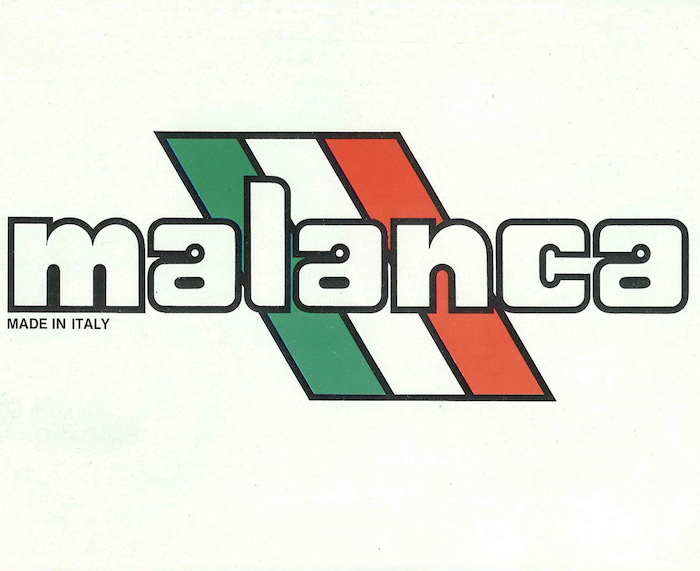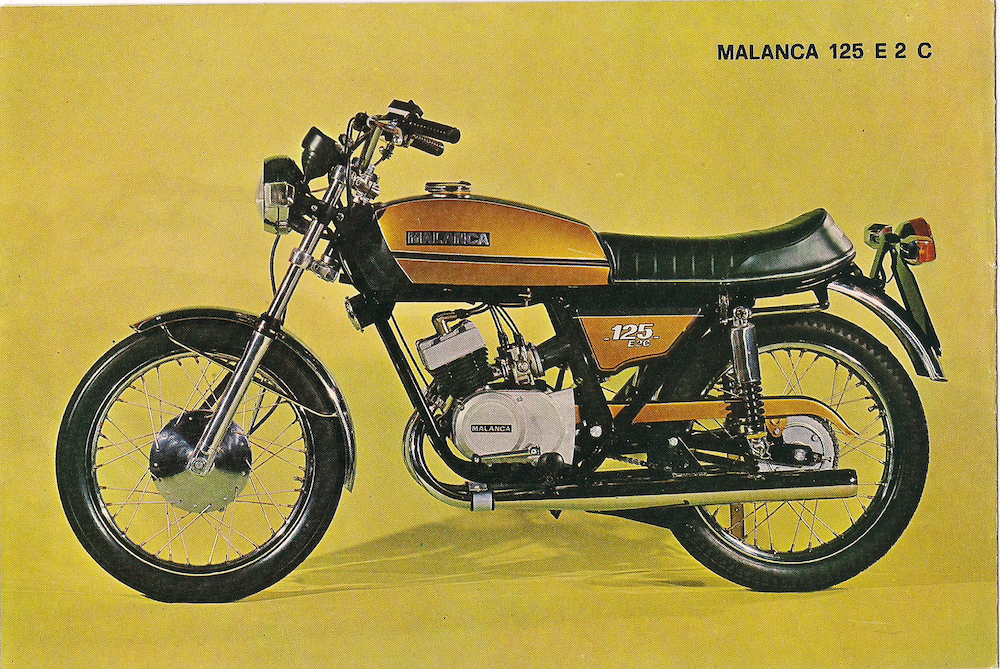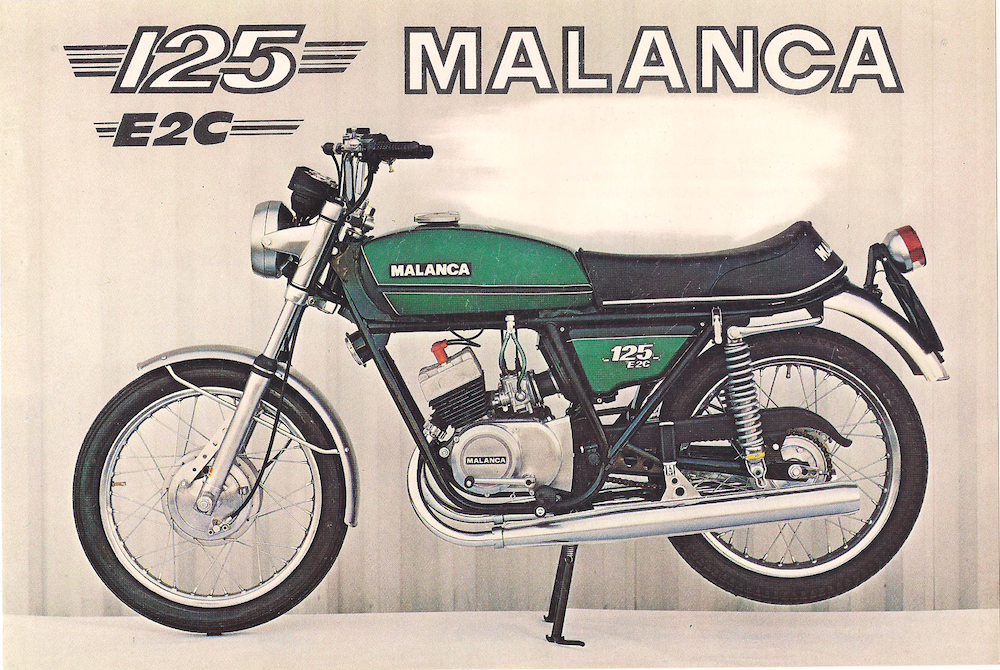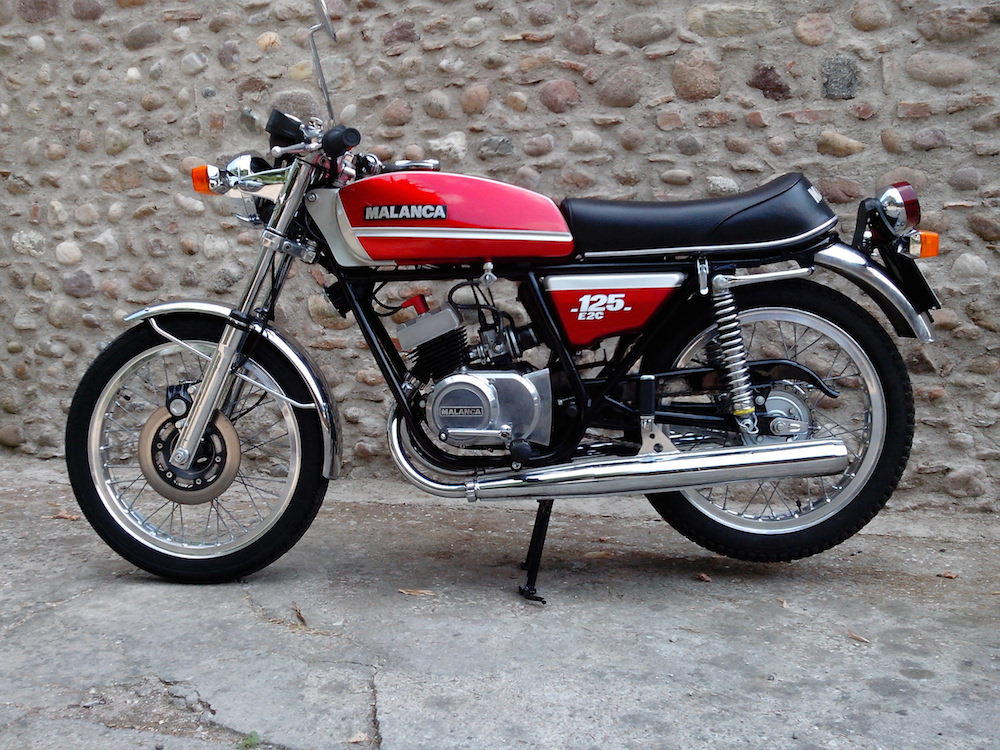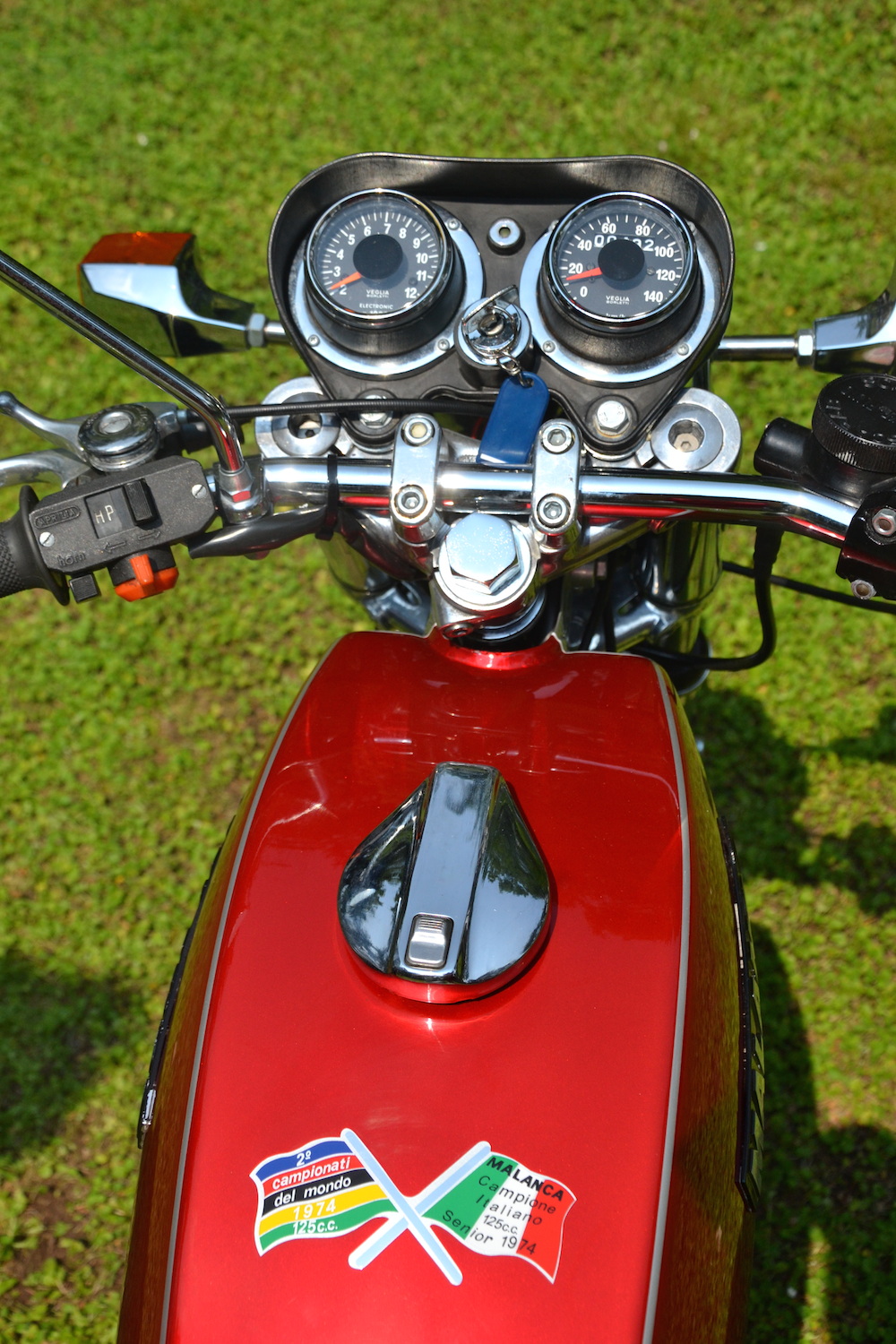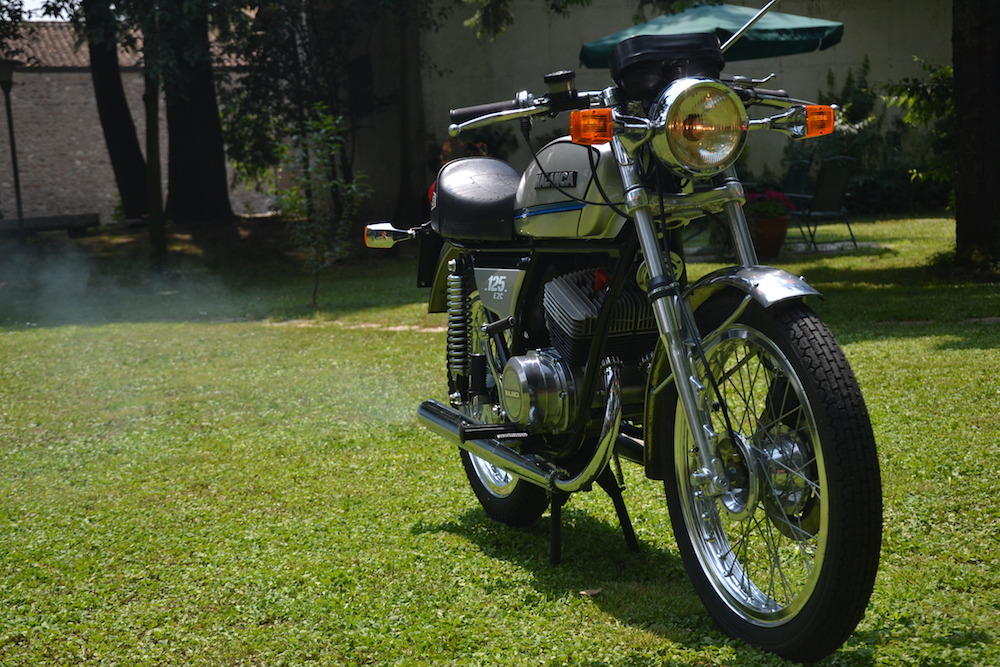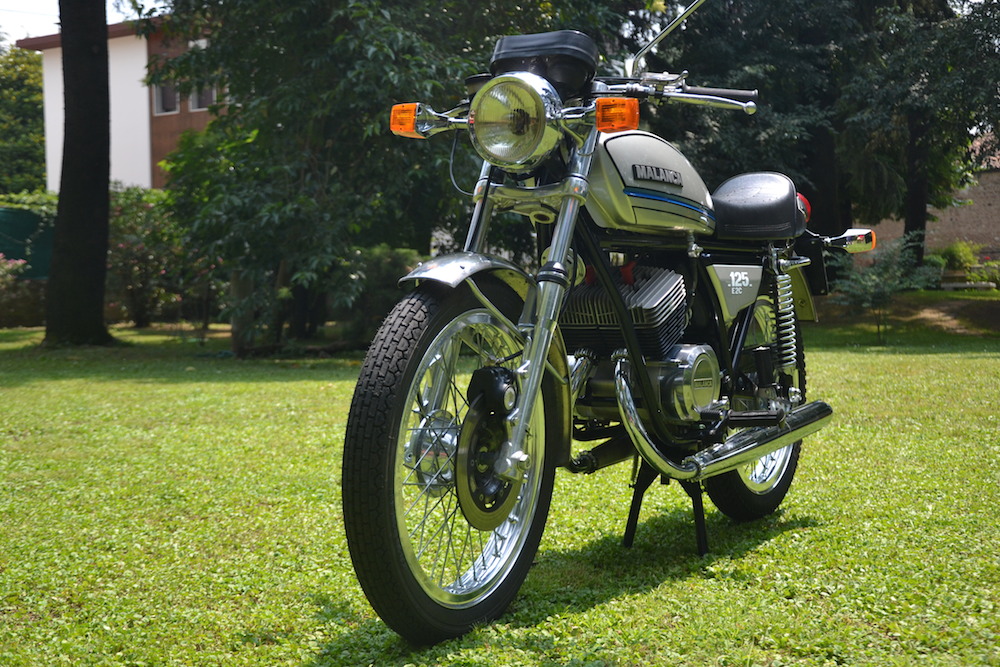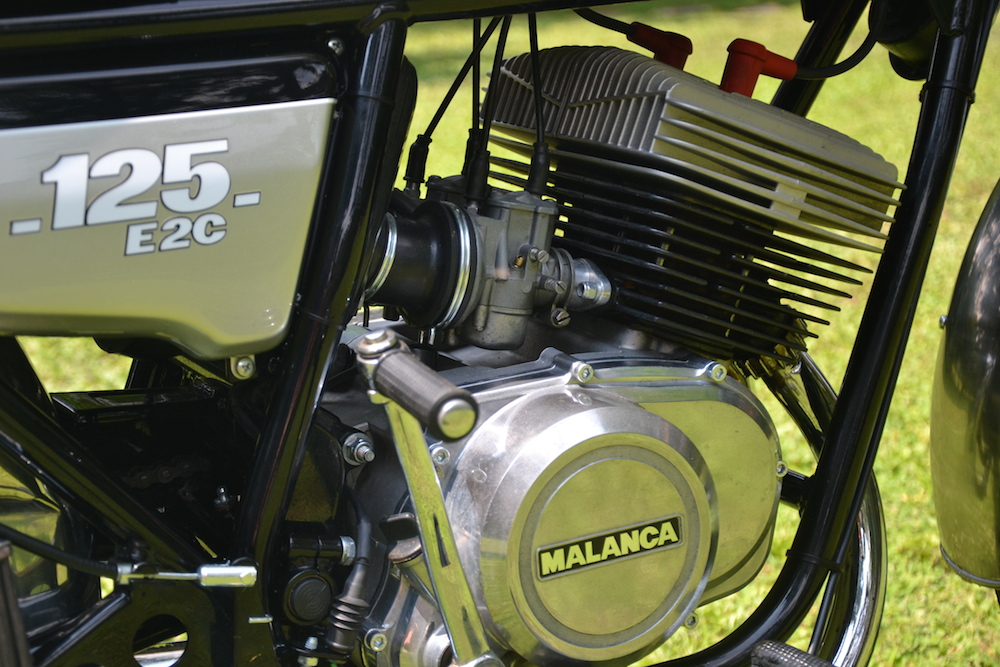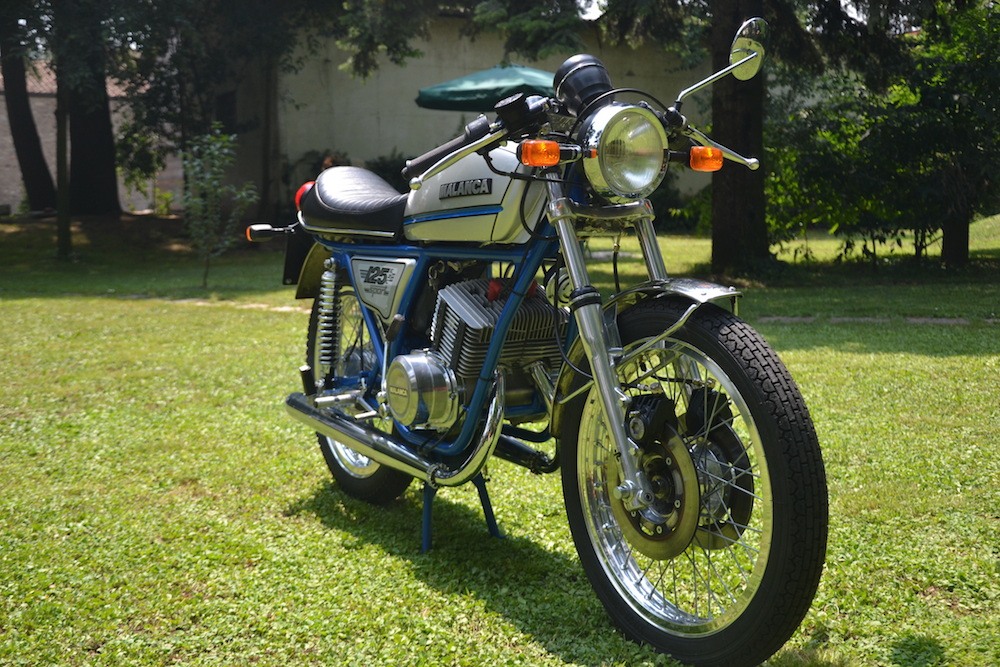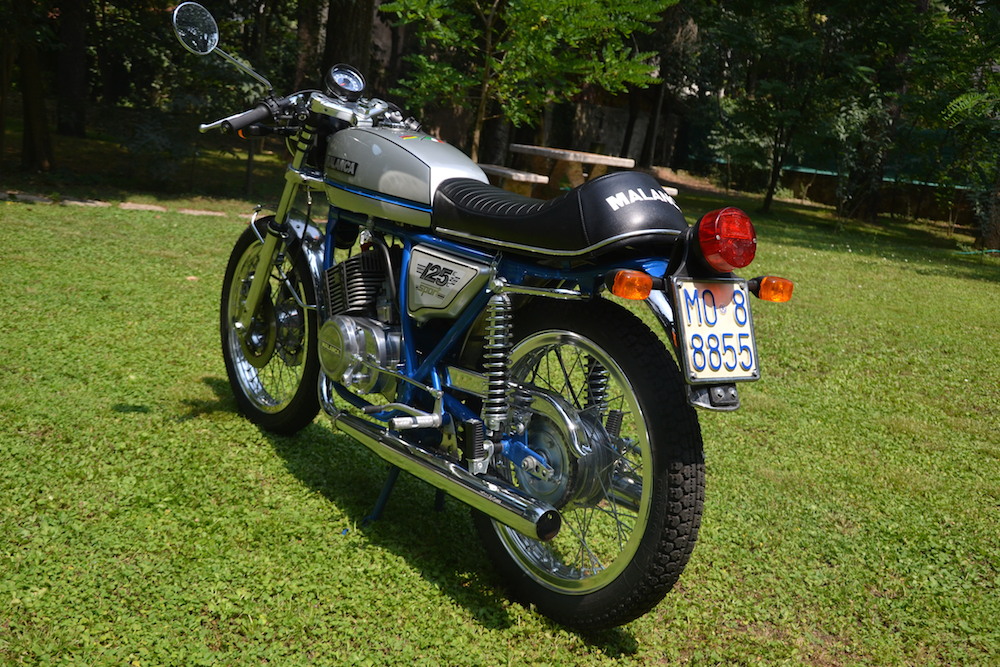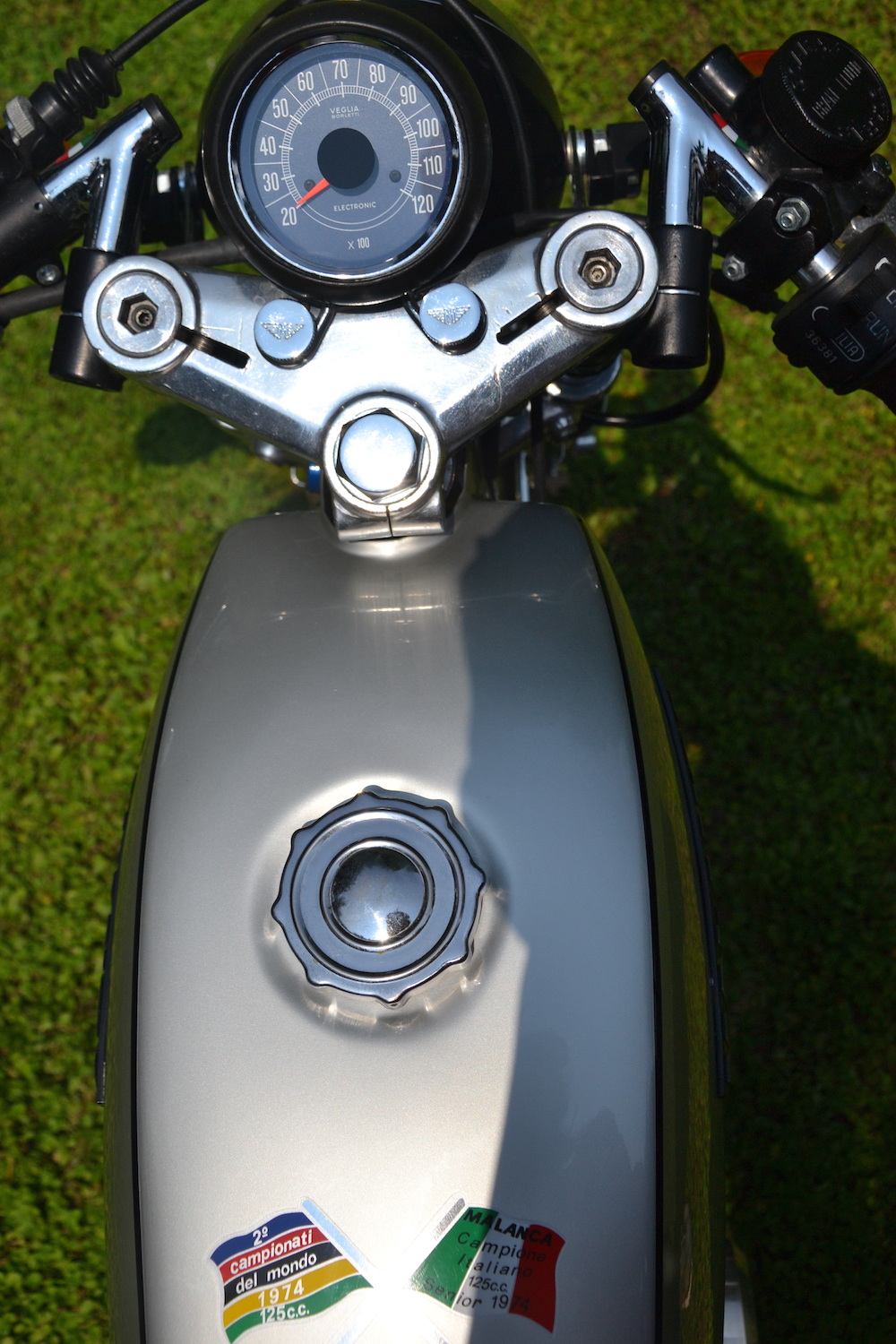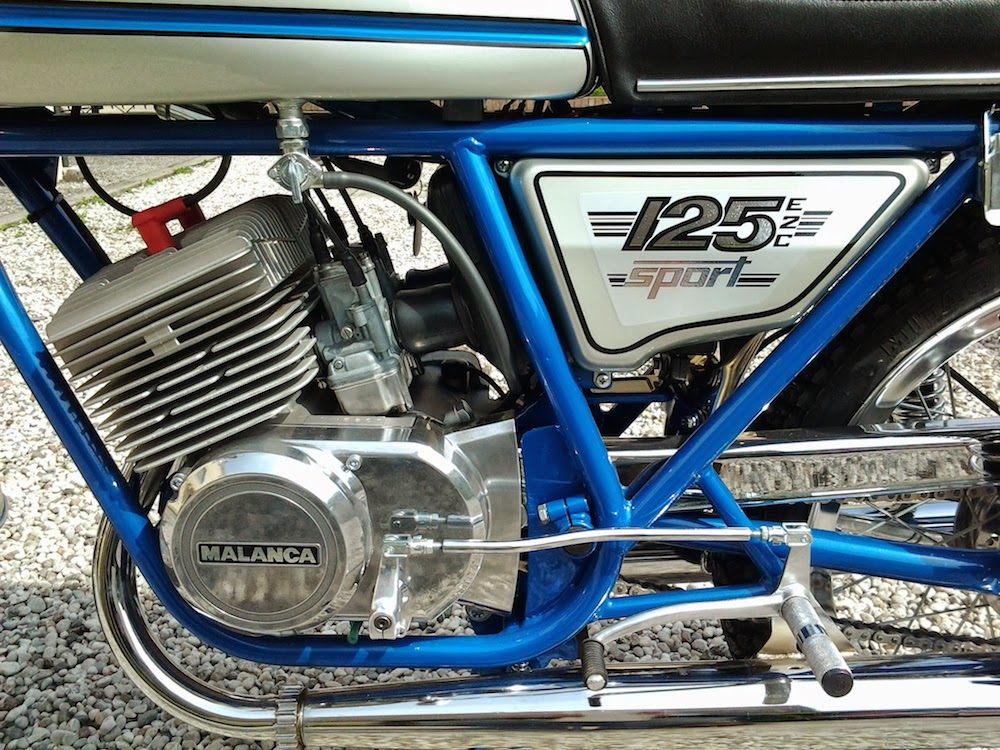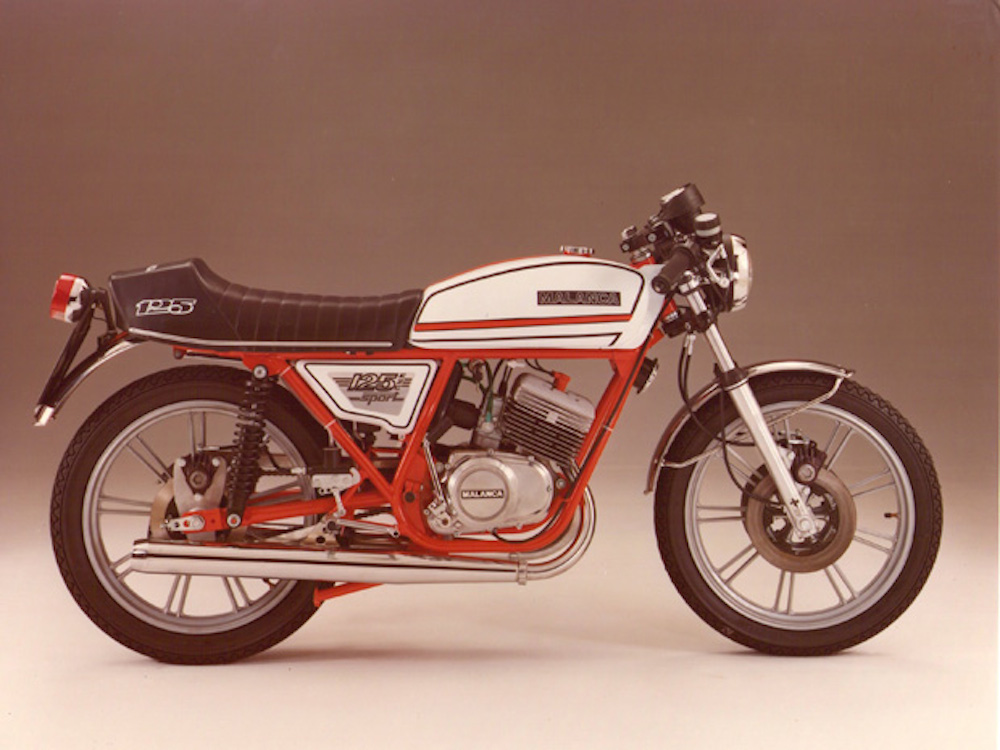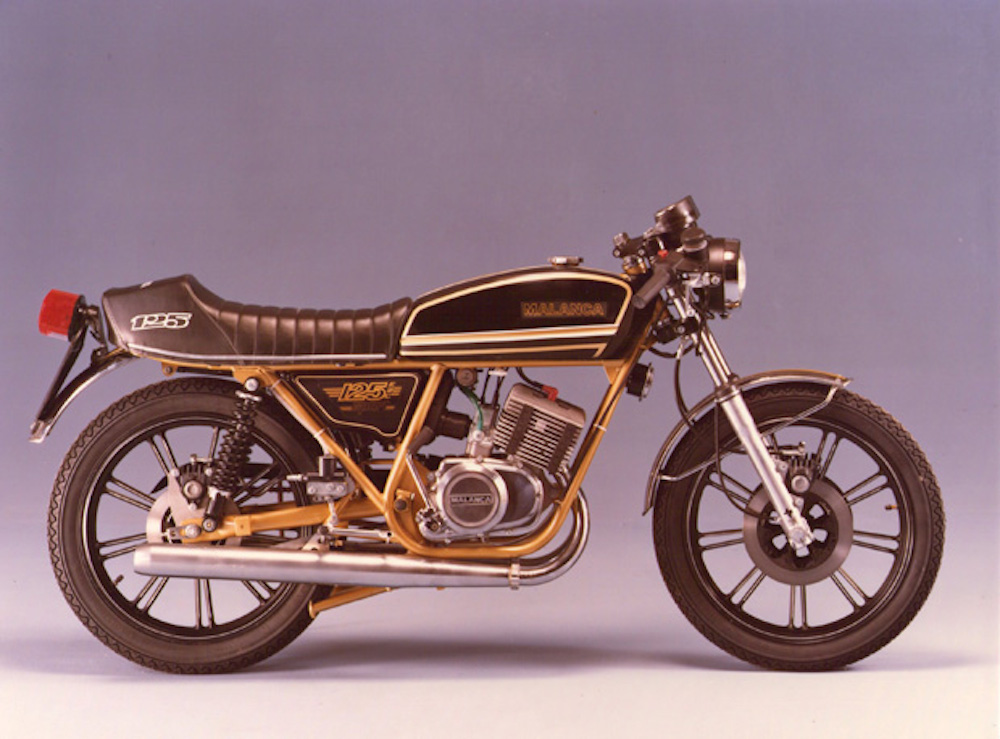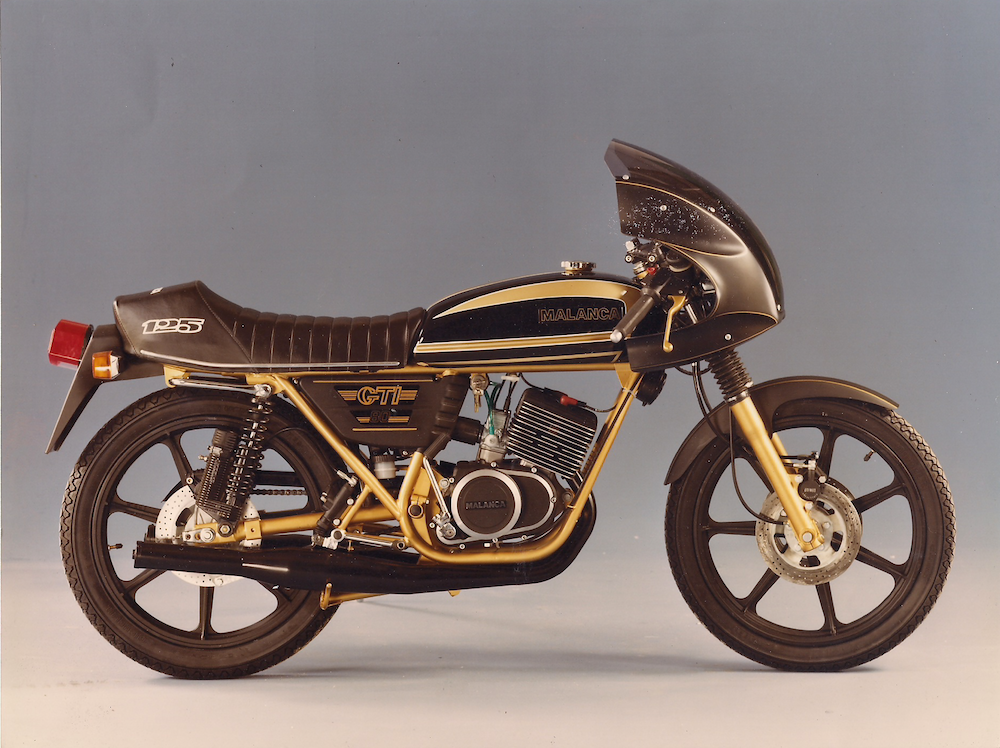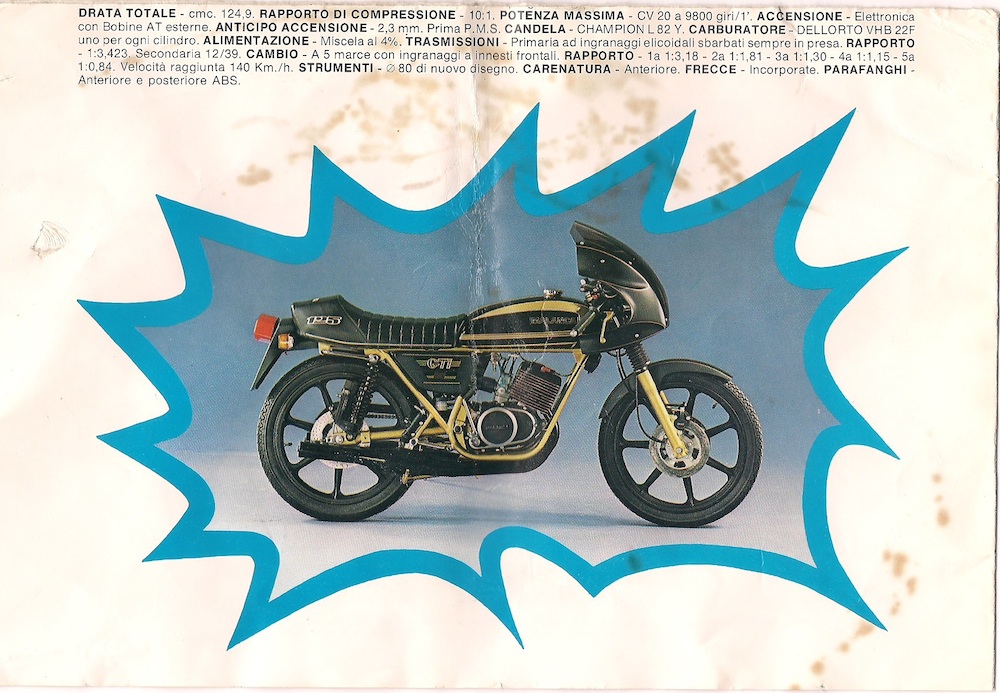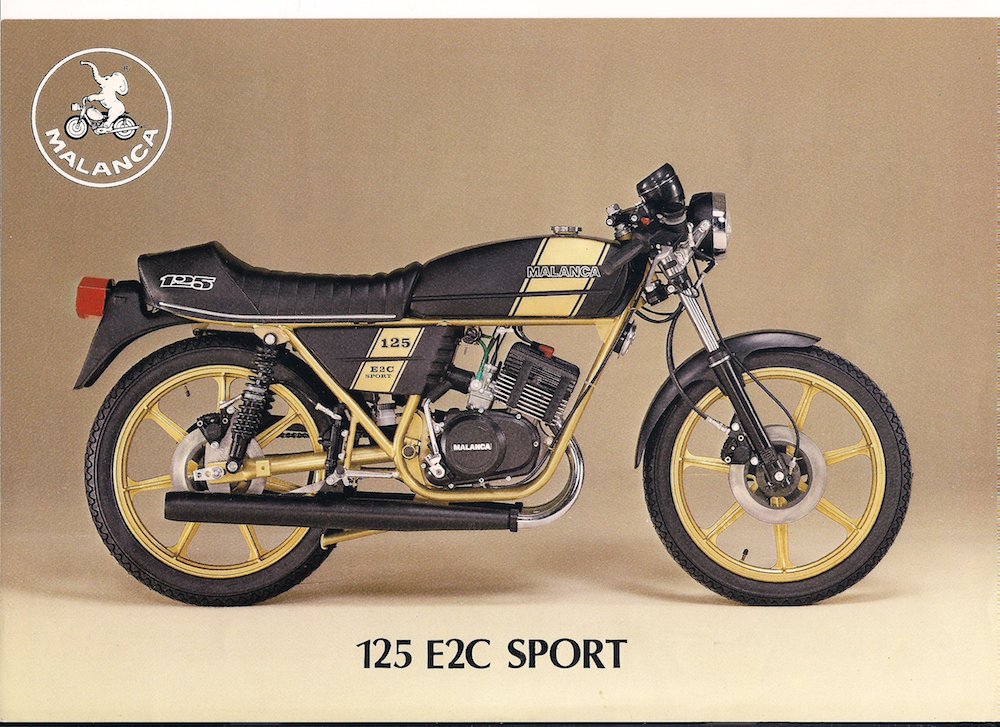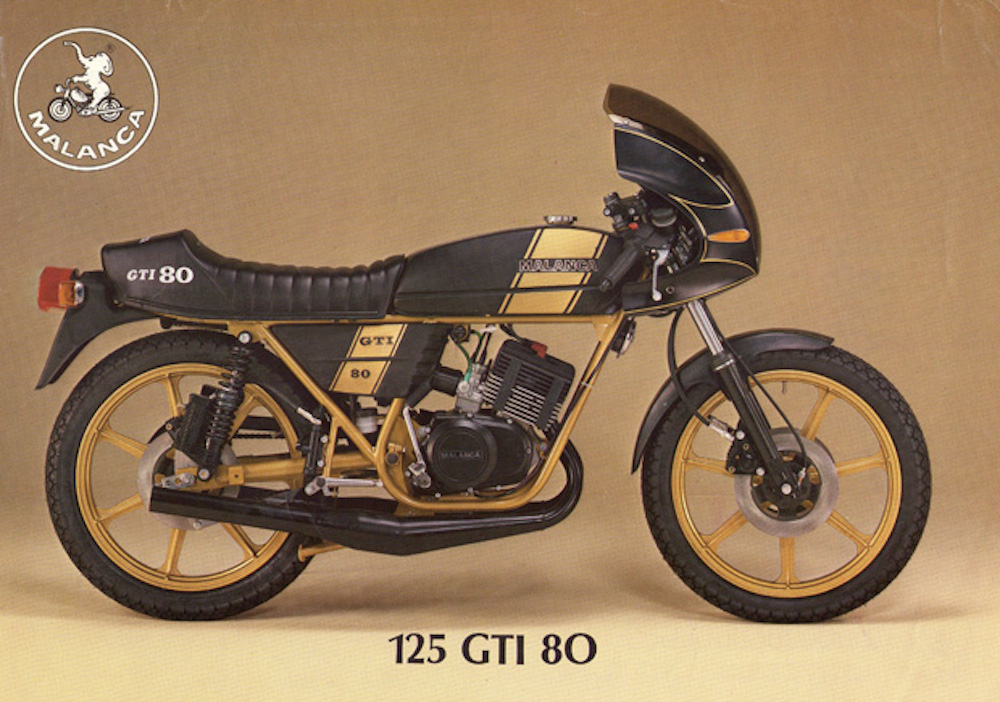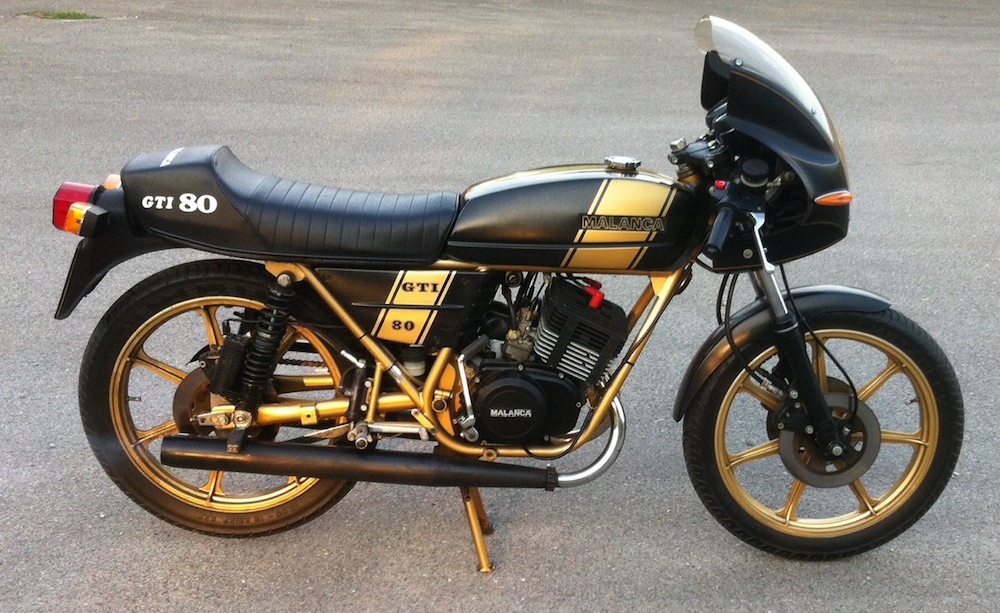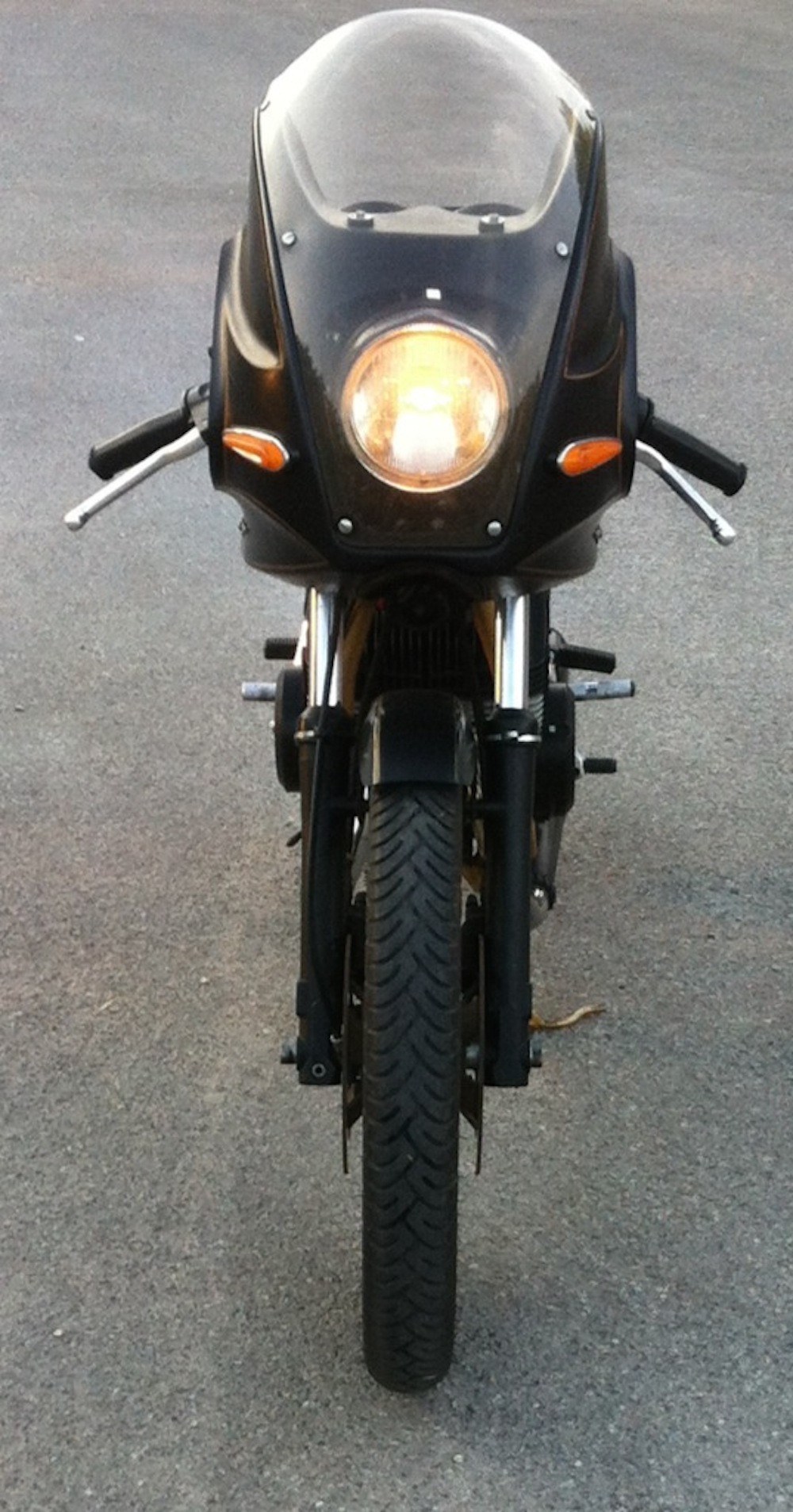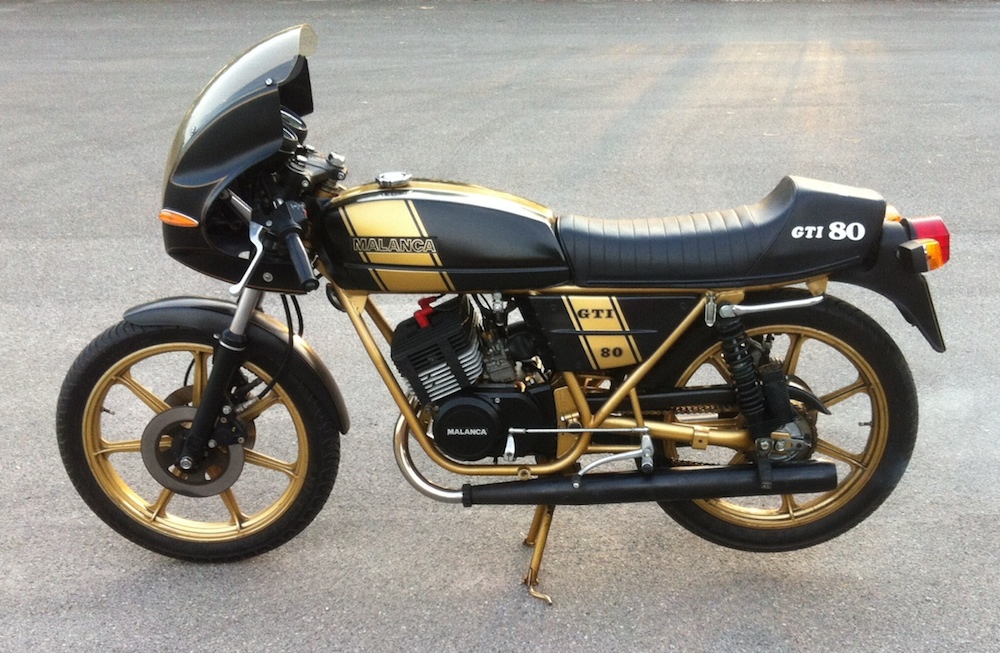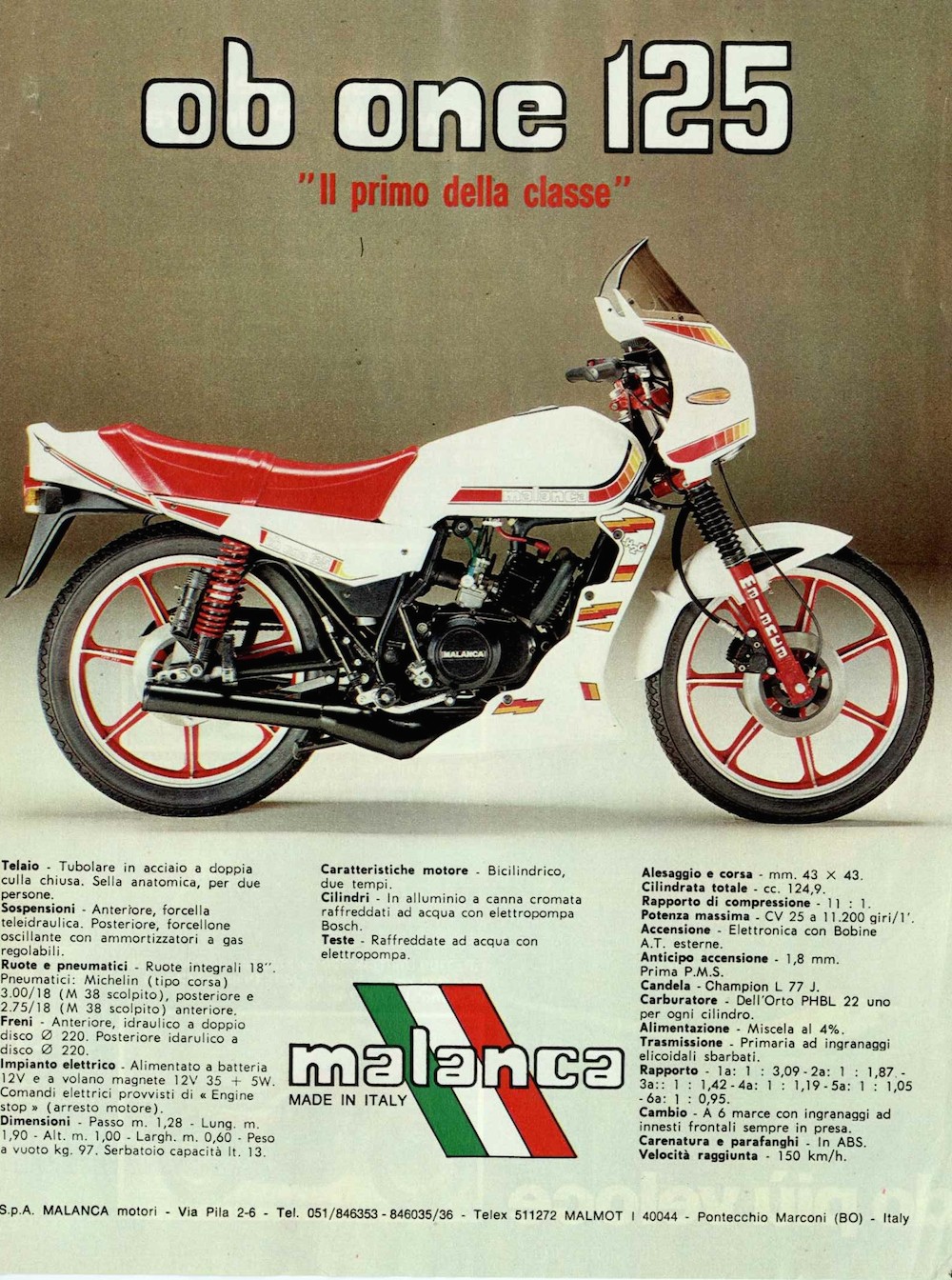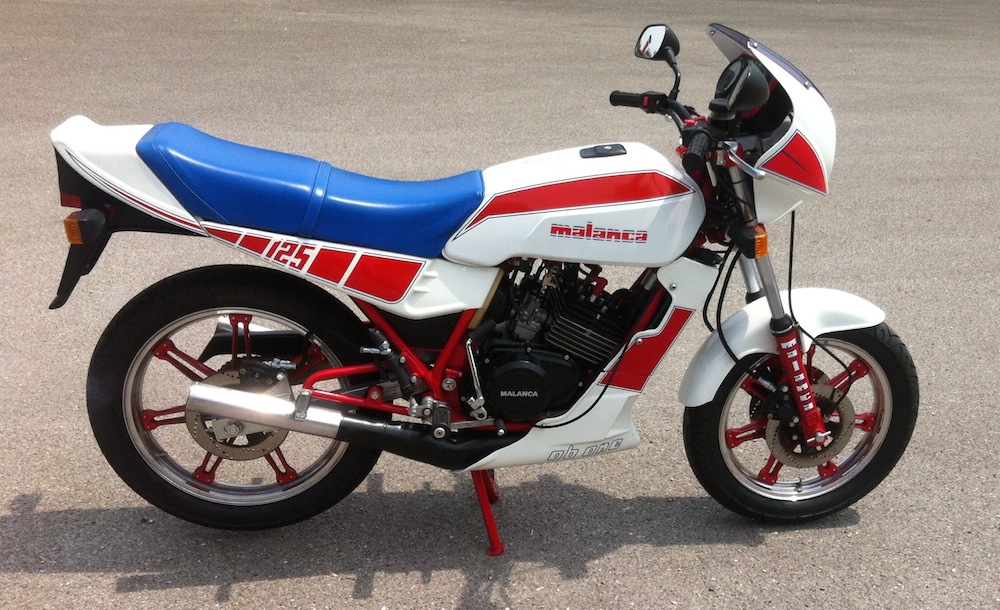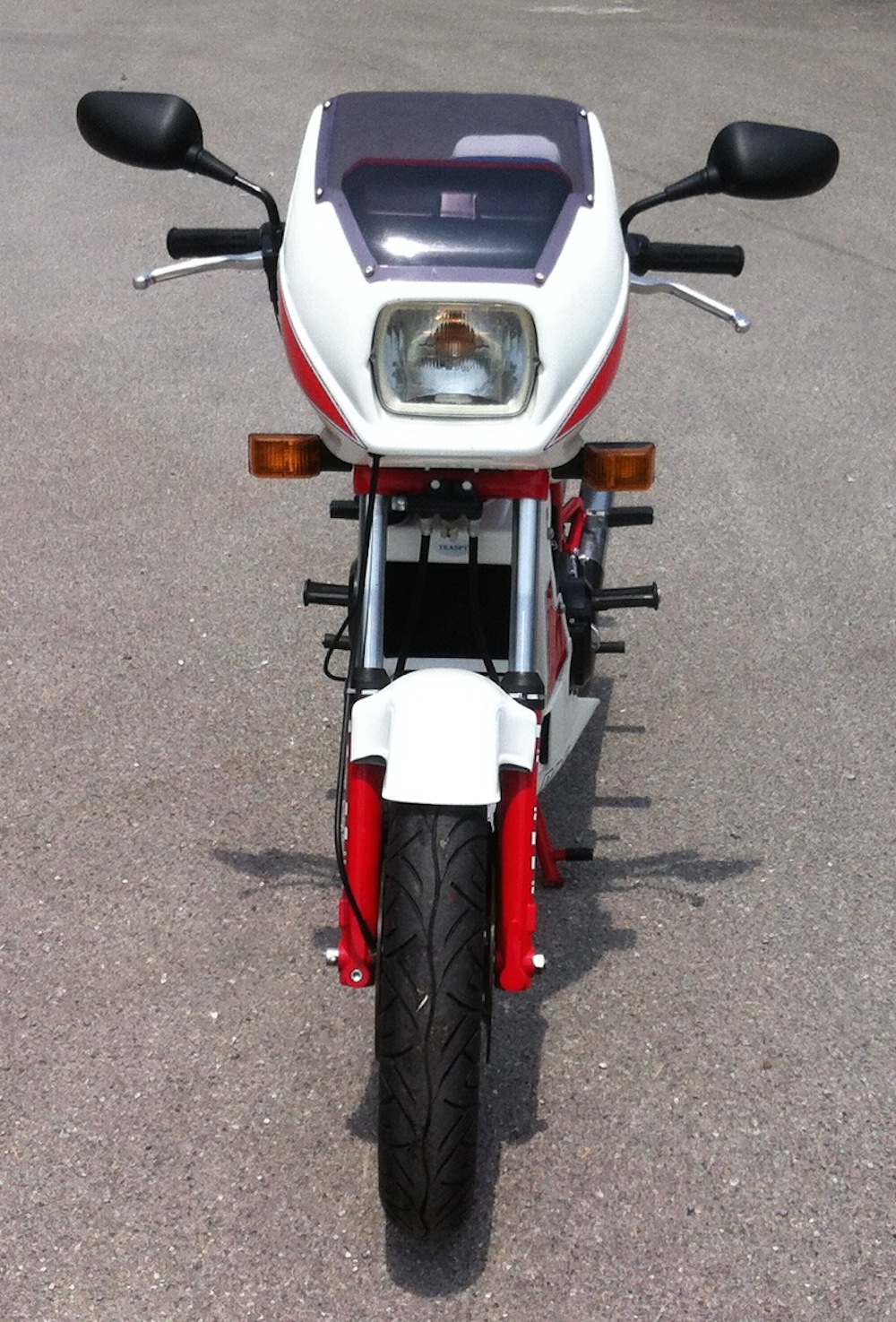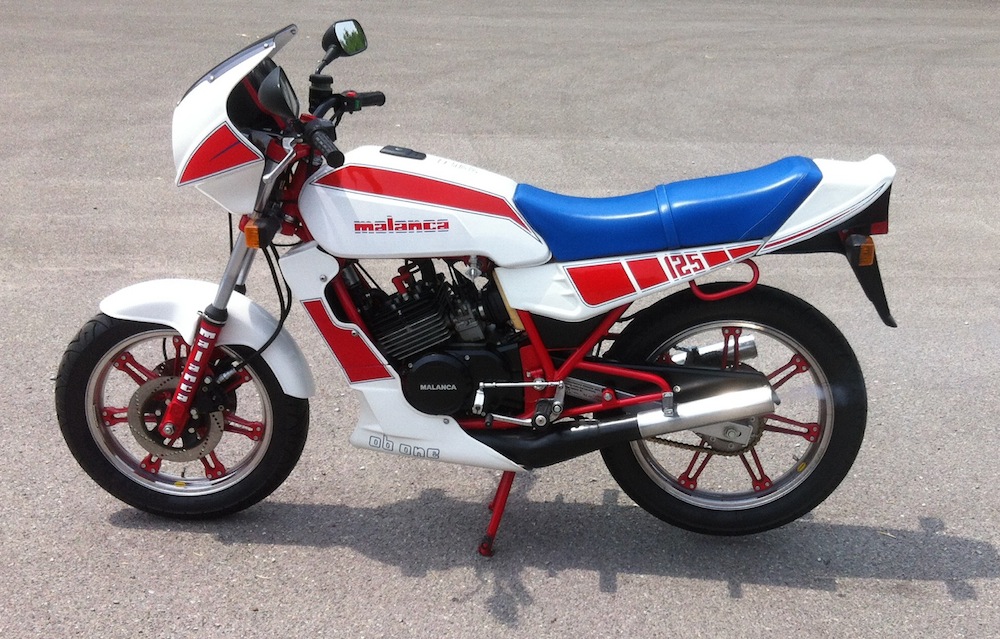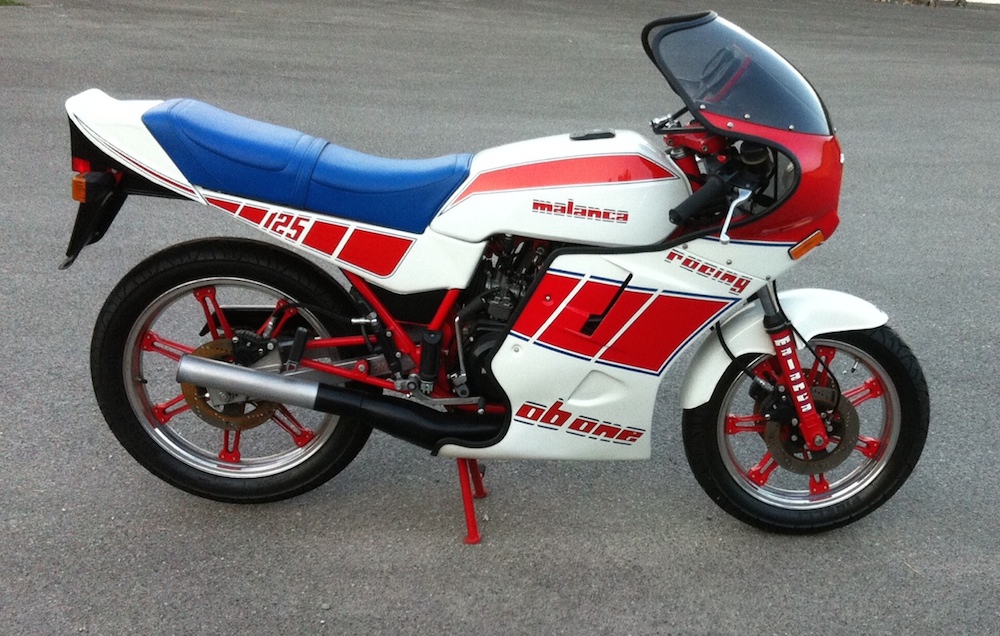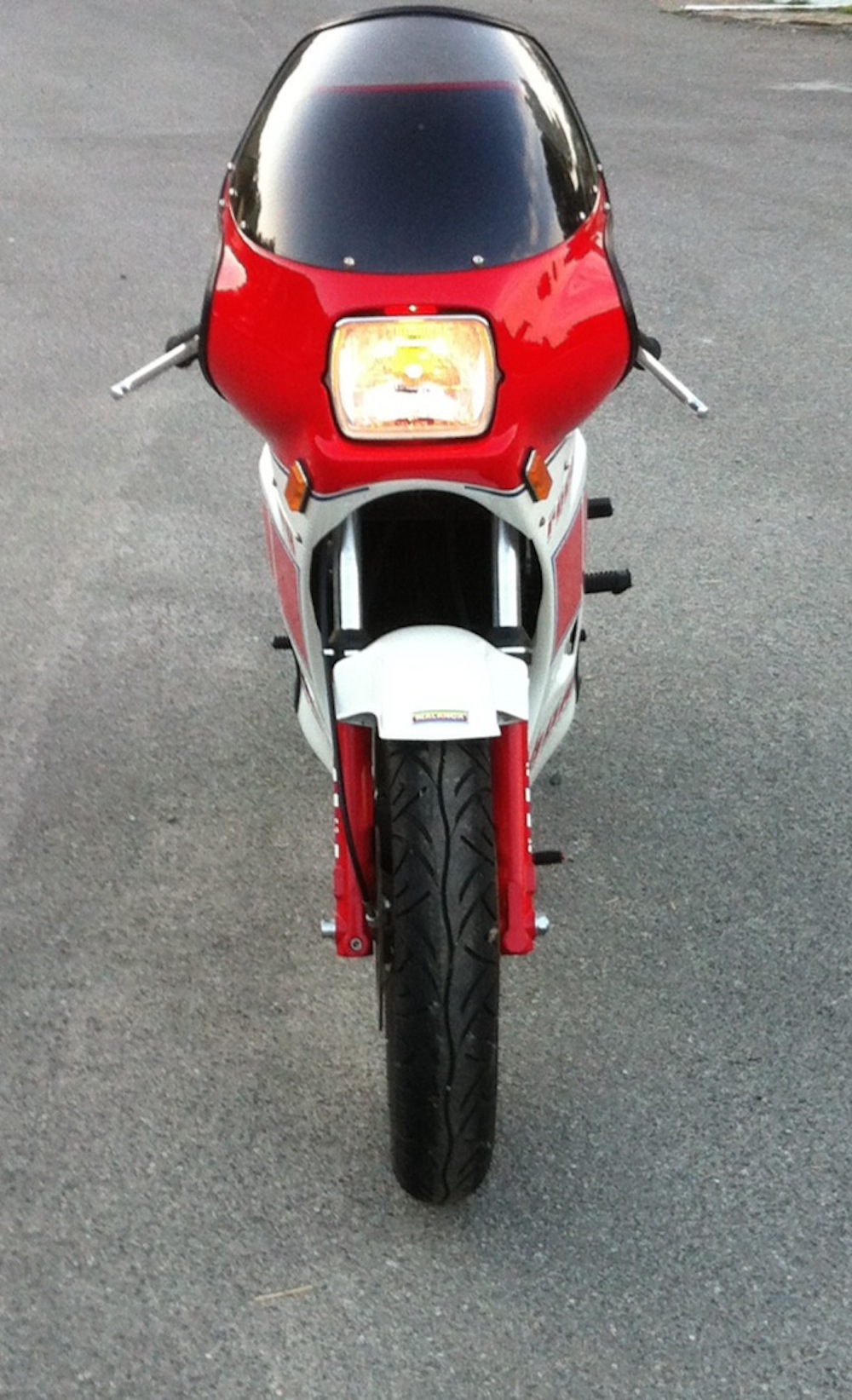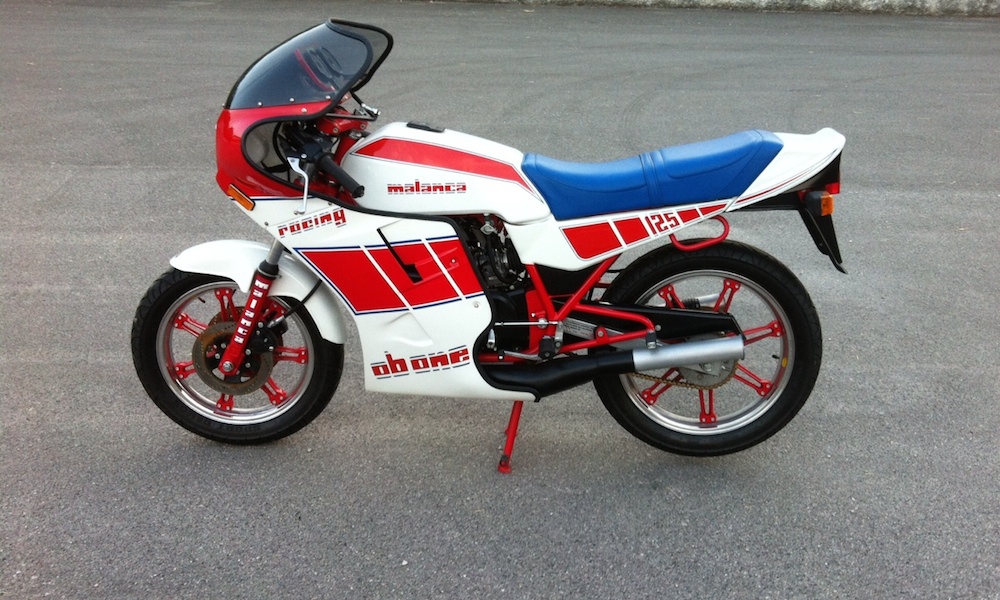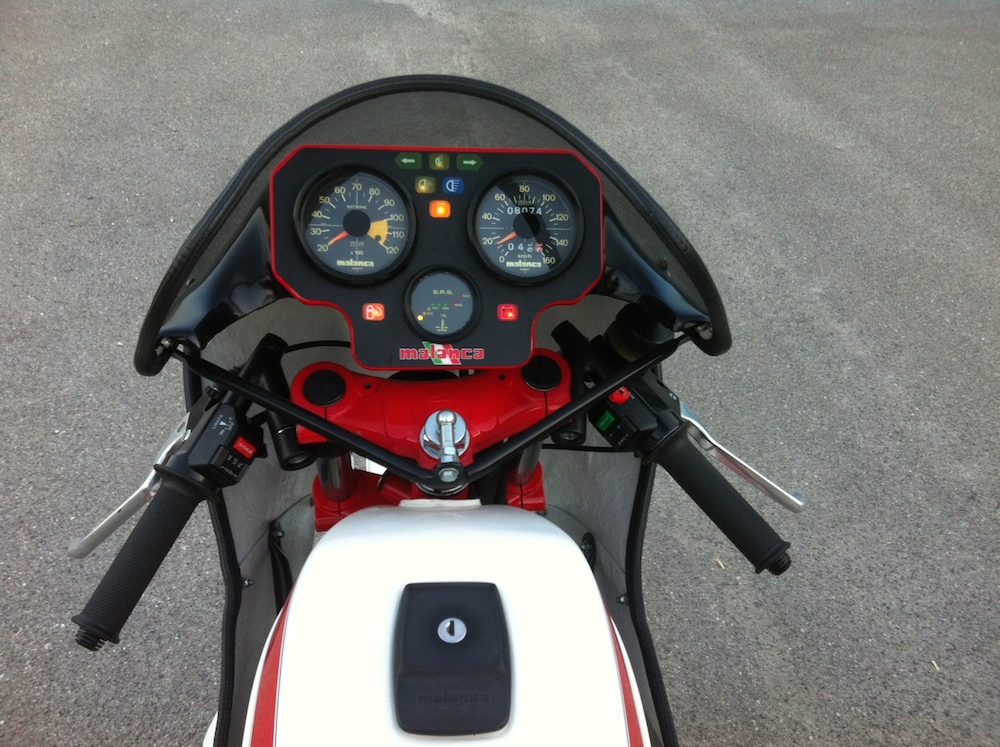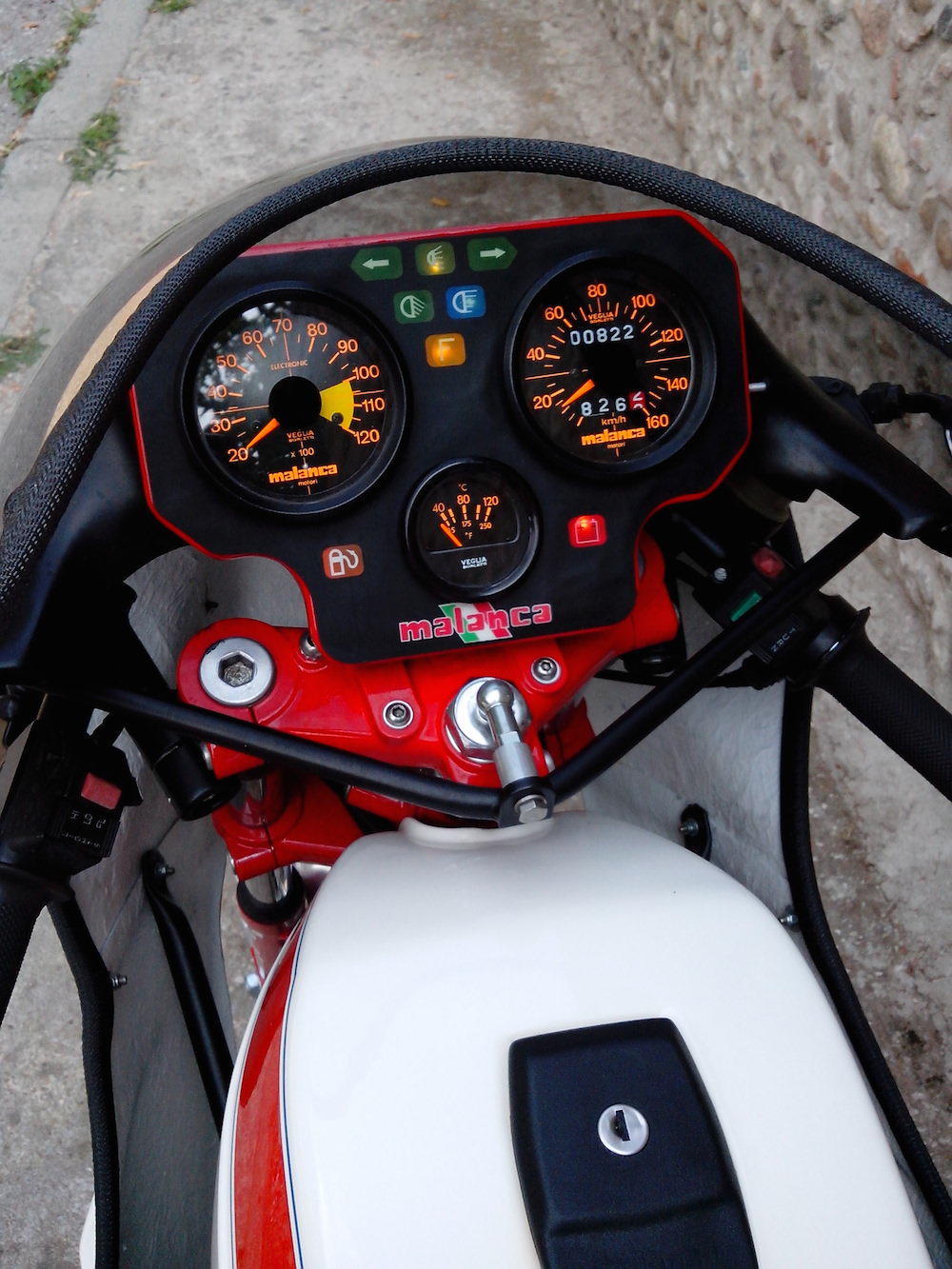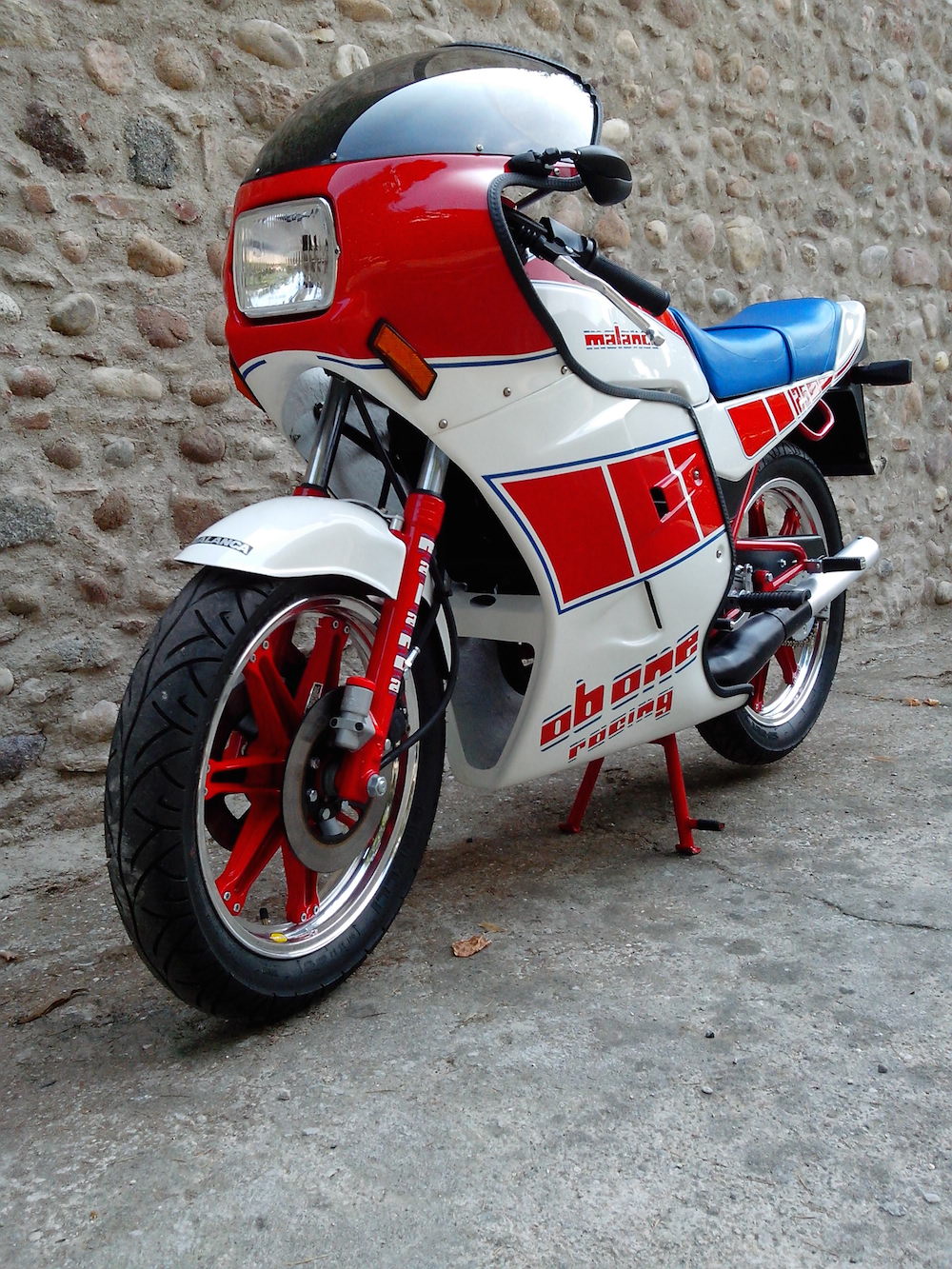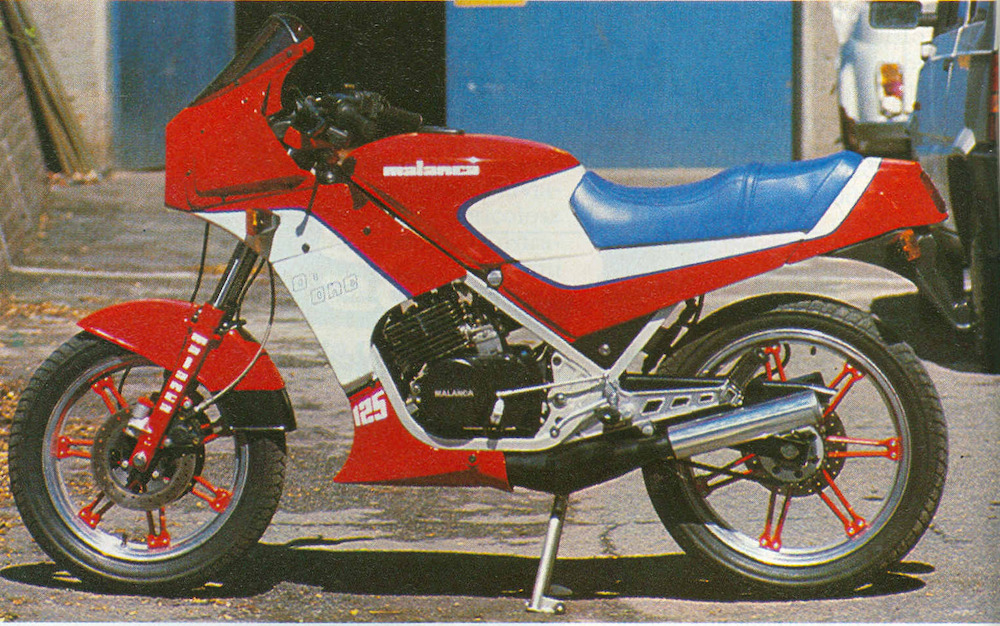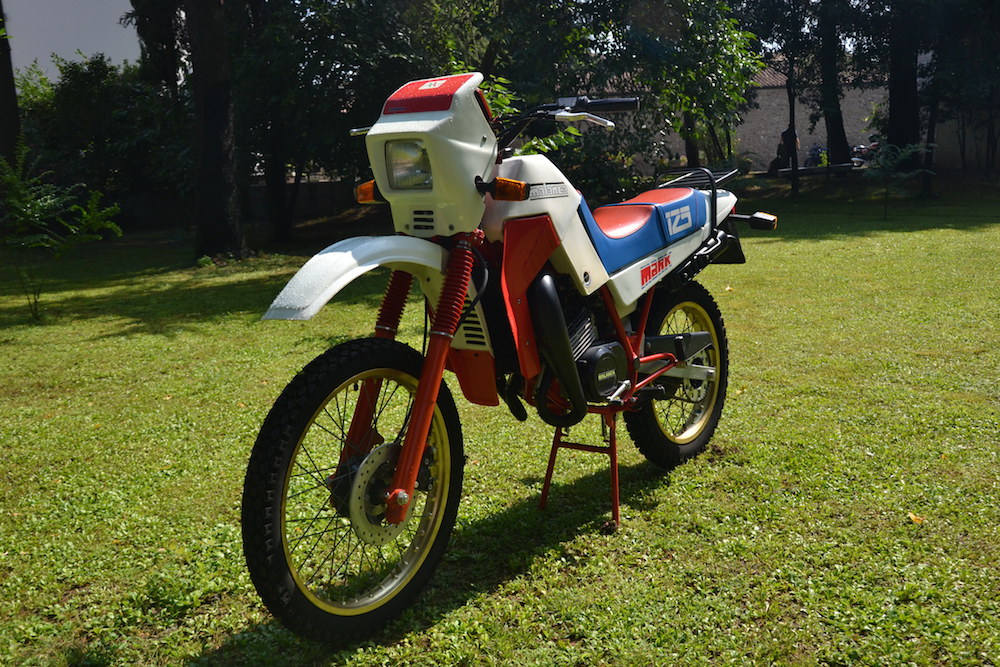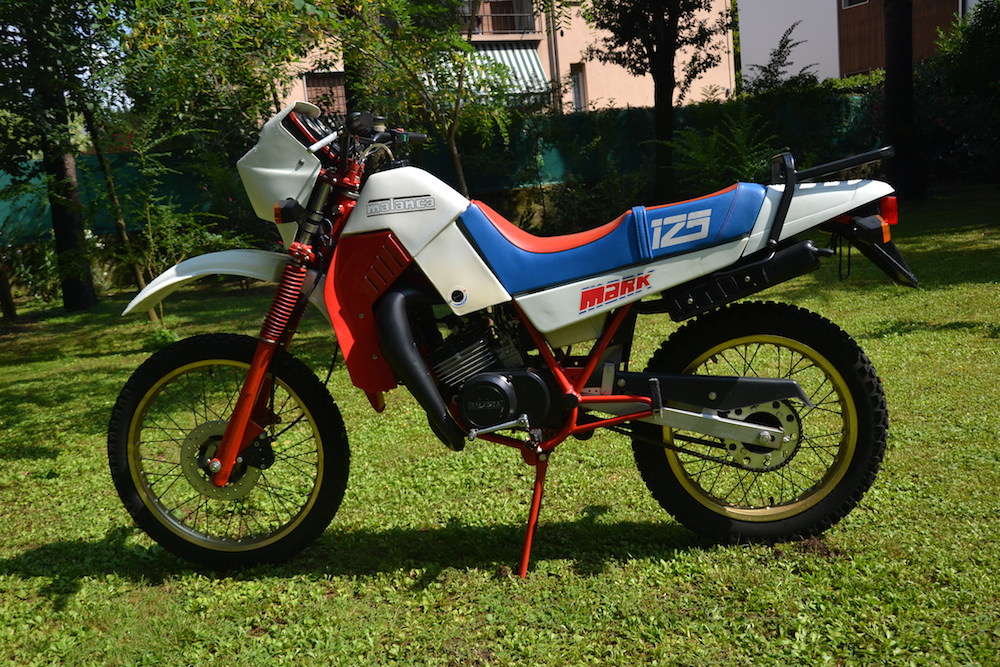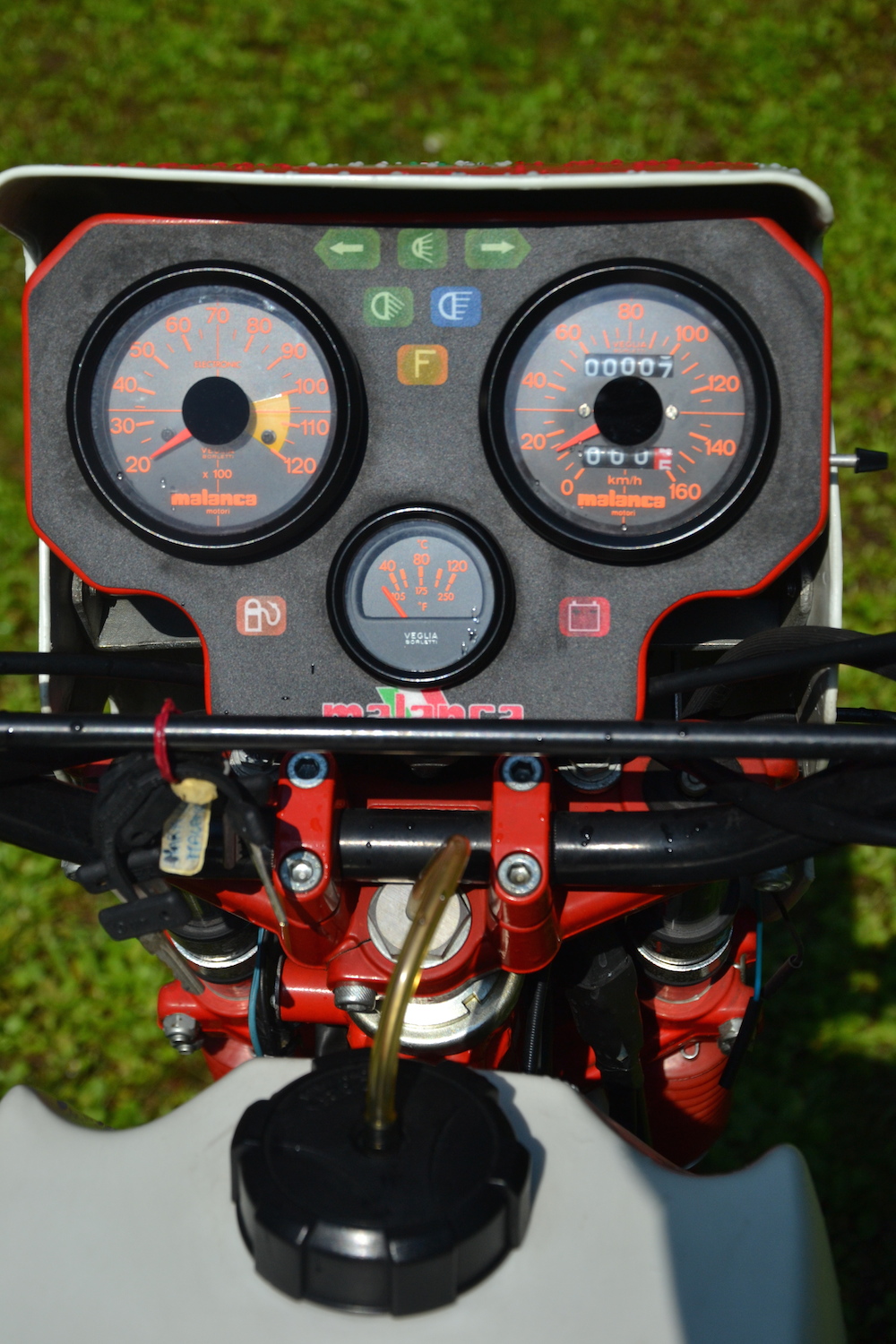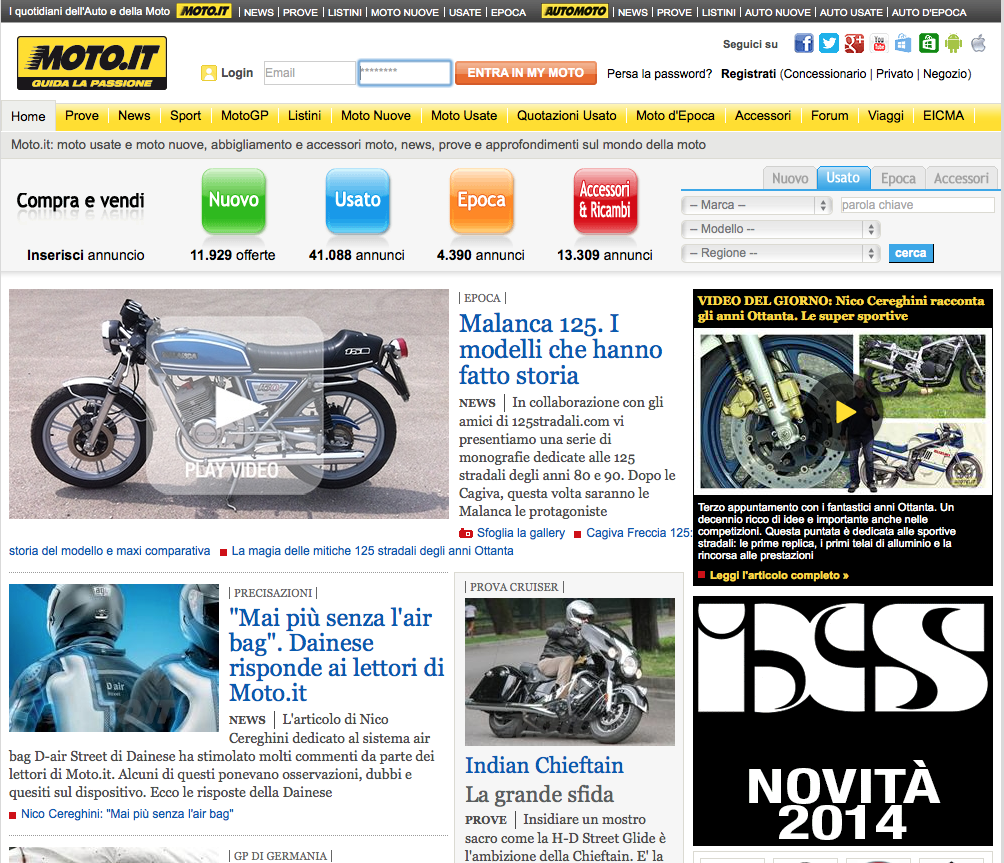125stradali.com ringrazia Alberto ed i suoi amici “malanchisti” per aver fornito il materiale per quello che crediamo essere l’articolo più completo che esiste in rete sulle favolose Malanca 125 bi-cilindriche. Contrariamente alle nostre consuetudini di catalogare solo 125 raffreddate a liquido, vista la totale assenza di informazioni in rete sui modelli 125cc Malanca e vista la grande conoscenza e passione di Alberto sul marchio Malanca, abbiamo deciso di recensire anche le favolose E2C ed E2CS raffreddate ad aria. Buona lettura.
Breve storia sulla Malanca
La Malanca inizia l’attività produttiva nel 1956, dedicandosi ai “48”, così si chiamavano allora i motocicli sino ai 50 cc. Il prodotto è competitivo nel prezzo e di buona fattura, tanto che nel corso del 1960 la ditta realizza a Pontecchio Marconi lo storico moderno stabilimento, trasferendovisi da Bologna.
Ma a Mario Malanca non basta assemblare motori altrui su delle ciclistiche marchiate Malanca: egli vuole un suo motore e nel 1970/71 realizza un proprio propulsore che andrà subito a motorizzare il “Testa Rossa”, sino a quel momento mosso da un Franco Morini. A titolo informativo, la Malanca si rifarà almeno in due casi al mondo delle auto da corsa: con il Testarossa verniciando la testa di rosso, con un chiaro richiamo alle Ferrari, e successivamenti nel 1978 con i colori della JPS per la E2CS (John Player Special Lotus).
Dopo aver dedicato oltre un decennio esclusivamente ai 50cc, Mario Malanca intuisce le potenzialità delle 125cc e nel 1973 presenta al salone di Parigi la sua prima bicilindrica di 125cc. Il motore è di concezione robusta e tradizionale e garantisce ottime prestazioni. A questo bicilindrico e ai suoi conseguenti aggiornamenti resteranno legate le sorti della Malanca sino alla chiusura. Nel 1974, nonostante un furioso incendio distruggesse il capannone e gli impianti, arriva nei concessionari la prima 125cc la E2C. La produzione si concentrerà successivamente sempre più sul bicilindrico di 125cc nelle sue varie evoluzioni.
Nel 1983 arriverà nelle concessionarie l’Ob-One, quella che fu allora e anche successivamente la prima bicilindrica 2 tempi di 125cc raffreddata ad acqua concepita per la produzione di serie. Avrà un discreto successo grazie all’elevato livello prestazionale. La moto portava le iniziali di Otello Buscherini, storico pilota della casa di Pontecchio Marconi.
L’intraprendenza del fondatore fu tale da intuire subito l’importanza della partecipazione alle competizioni per acquisire quella fama e prestigio necessari a spingere poi con maggior vigore la commercializzazione della produzione di serie. I risultati nella classe 125 con una Suzuki che porta i colori Malanca e preparata dal tecnico Giancarlo “Fuzzi” Librenti saranno lusinghieri. Il pilota Otello Buscherini ottiene quattro vittorie nel 1973 e diversi piazzamenti e vittorie nel 1974 che varranno alla Malanca, nel 1974, un 4° posto assoluto nel Campionato del Mondo ed il 1° posto assoluto nel Campionato Italiano Seniores (Otello Buscherini) e nel Campionato Italiano Seniores di Marche. Purtroppo, nel 1976 a seguito dell’incidente mortale di Buscherini, Malanca si ritira dalle competizioni. Un ritiro brevemente interrotto dal rientro nelle competizioni nel 1985, con una 250 preparata sempre da Librenti, che però non porterà a nessun risultato concreto.
La Malanca pose definitivamente e volontariamente fine alla sua attività produttiva nel corso del 1987 quando la famiglia decise di chiudere.
Le 125 stradali bi-cilindriche
1974/1975: E2C “cilindri piccoli”
Al Salone di Parigi del 1973, sull’onda dei successi della 125 bicilidrica condotta in gara da Otello Buscherini, la Malanca realizza una 125 sempre bicilindrica da affiancare alla sua produzione sino allora incentrata sui 50 cc: arriva la E2C, un acronimo che significa Elettronica 2 Cilindri.
Il prototipo presentato è caratterizzato da un colore verde oliva mai arrivato alla produzione.
Il progetto e la messa a punto della E2C vengono seguiti dal responsabile del reparto corse della Malanca Gianpaolo Librenti (detto Fuzzi), valido tecnico in grado di consentire ad Otello Buscherini di combattere per il Mondiale già dal primo anno di partecipazione della Malanca nella classe 125.
La E2C prima serie monta un motore bicilindrico con cilindri in ghisa caratterizzati da una ridotta alettatura (da cui il soprannome “cilindri piccoli” che caratterizza le prima E2C) e teste in lega alimentato da due carburatori SHB 19. L’accensione è elettronica ed il cambio a 5 marce. La Malanca dichiara a conforto della solidità del progetto che il gruppo bielle e albero erano sostanzialmente gli stessi del modello utilizzato nelle competizioni e soggetto a ben altre sollecitazioni. La potenza dichiarata è di 15cv Din a 8000 giri, con un sorprendente tiro ai bassi regimi e con una curva di coppia che si stende regolare sino al massimo regime. Un motore quindi facile ed adatto a tutti i percorsi.
La E2C “cilindri piccoli” viene prodotta nel 1974 e 1975 e la componentistica tra i due model year rimane esattamente la stessa. A E2C vengono proposte con:
> Manubrio alto – solitamente abbinato a cerchi in acciaio Redaelli e freno idraulico all’anteriore
> Manubrio diritto basso – solitamente abbinato a cerchi Borani in lega e disco all’anteriore.
Ma appunto solitamente, non era una regola ferrea.
Per quanto attiene ai codici omologativi DGM o OM, la E2C ’74 in pratica non li ha! Il dato che ha dell’incredibile, ma con Malanca tutto è possibile. Sul telaio compare la scritta DGM OM ma non vi è nessun numero che identifichi, appunto, il codice omologativo.
Ciao
L’unica differenza tra il mod. 1974 e 1975 è quindi data dalla colorazione:
E2C modello’74: bronzo o verde entrambe con telaio nero. Gli inserti serbatoio e fiancatine sono neri.
E2C modello ’75: rosso amaranto o azzurro scuro con telaio nero. Inserti serbatoio e fiancatine grigio chiaro. (Rimangono in produzione le colorazioni ’74 che mantengono gli inserti neri). Sulla E2C mod. ’75 compare il codice DGM 13746 OM che rimane il medesimo sulla E2C ’76 e su tutte le E2CS fino al ’79.
A discapito di ciò che viene riportato su alcune brochure, la sigla E2CS (dove S sta per Sport) non vedrà la produzione effettiva prima del 1976.
Il prezzo nel 1974 è di Lire 520.000 su strada.
1976: E2C & E2CS “monostrumento”
Nel 1976 la Malanca propone sul mercato due modelli della sua 125 stradale: la turistica E2C ispirata al primo modello del 1974 ed un’inedita versione sportiva chiamata E2C Sport.
La E2C quale mantiene gran parte della componentistica del modello ’74, mentre il motore viene dotato di nuovi cilindri sempre in ghisa, ma con alettatura estesa di maggiori dimensioni, e di diverse e più grandi testate. I carburatori restano i due 19 SHB, ma le prestazioni aumentano e al gran tiro che caratterizzava il primo motore ora si aggiunge anche una certa capacità di allungo.
La E2C Sport, presentata sempre nel 1976, è invece una moto completamente nuova sia nel telaio che nell’estetica, oltre che nel resto della componentistica. Di forte connotazione sportiva, caratteristica è la presenza del solo contagiri ben posizionato centralmente sulla plancia, che le vale il nomignolo di “monostrumento”. Ma è soprattutto nel nuovo motore che Malanca si distingue dalla concorrenza, realizzando quello che si dimostrerà il più potente bicilindrico per la categoria 125 stradali.
Il motore monta due nuovi cilindri in lega ed è alimentato con due carburatori da VHB da 22 mm divenendo il capostipite di tutte le successive 125 stradali che caratterizzeranno la Malanca per tutto il decennio successivo. La potenza aumentava a 18 Cv e 9800 giri anche se il nuovo propulsore fatica ad esprimersi nel suo potenziale, così come è soffocato dall’airbox e chiuso dalle due marmitte cromate. L’impianto frenate viene mutuato dal modello utilizzato in pista da Buscherini e conta su due dischi all’anteriore ed un efficace tamburo al posteriore. Il prezzo passa a 920.000 lire su strada.
1976: E2C 150
Sempre nel 1976 viene anche realizzata una versione da 150cc sia in veste turistica che sportiva. Le prime brochure evidenziano la E2C 150cc con cerchi a raggi e un solo disco all’anteriore oltre che il manubrio rialzato caratteristico dei mod. turismo. Non è dato sapere se alcune 150 siano o meno poi state effettivamente commercializzate in questa versione.Il motore ha 20cv a 9200 giri e viene proposta per Lire 990.000 su strada.
La 150cc introduce per la prima volta un telaio non verniciato di nero.
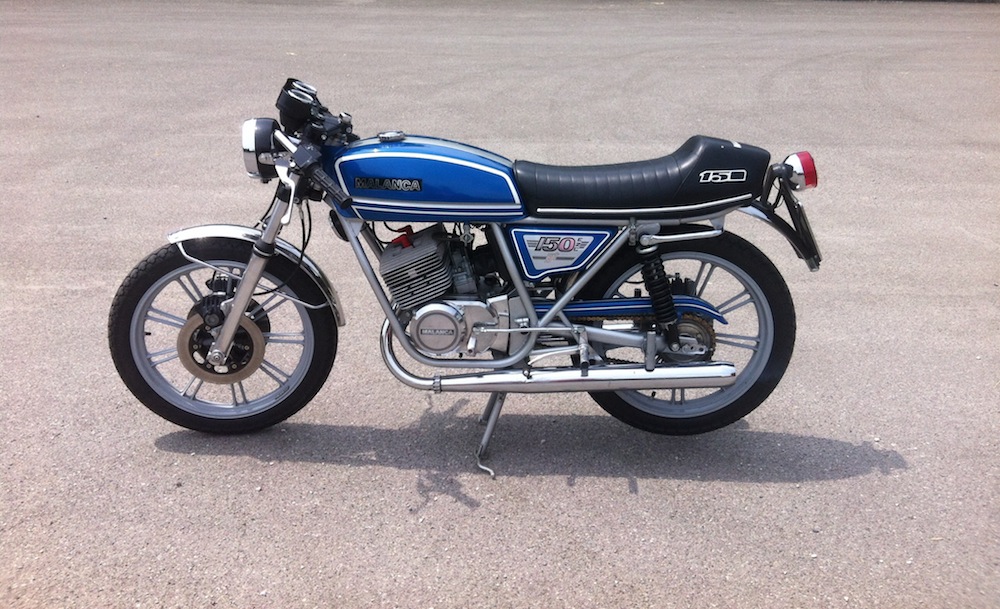
Negli anni in cui rimane in produzione segue poi gli aggiornamenti visti sulla 125. Qui sotto la versione 3GTI Sport che riprende la colorazione JPS del 1979.
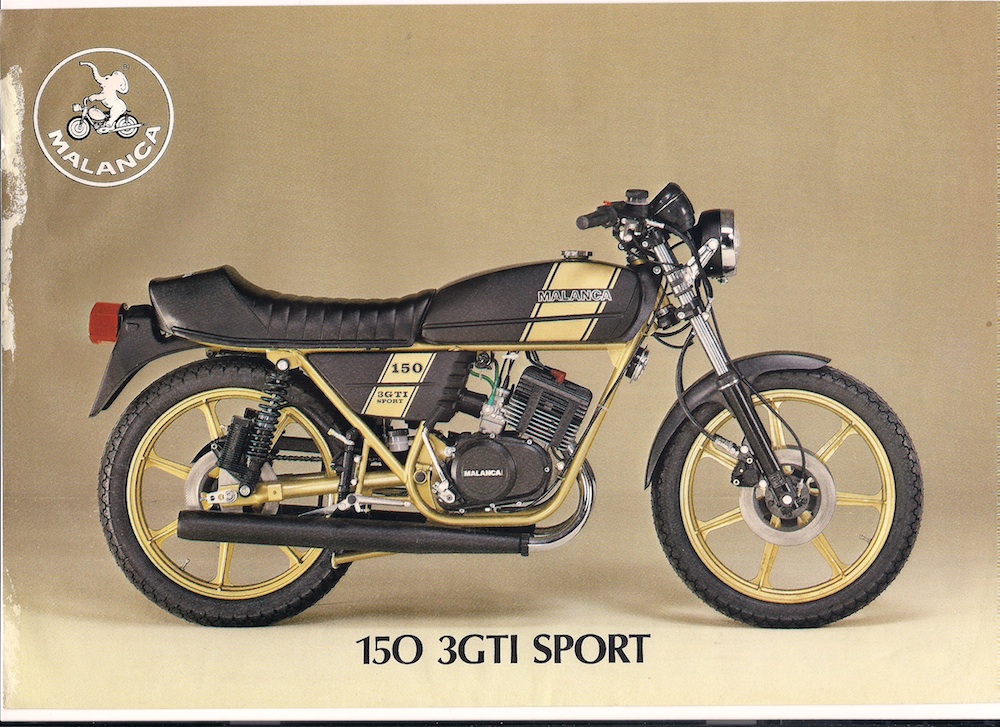
1977: E2CS
Tra il 1976 ed il 1977, come spesso accade per la produzione italiana del periodo, le novità del modello ’77 vengono introdotte sulle ultime ’76. Quindi esistono delle versioni assemblate con quanto disponibile. Ad esempio, alcune tra le prime E2CS ’77 montano ancora la sella del mod. ’76 con un unico strumento contagiri e le ruote in lega.
Nel 1977 la produzione comunque si concentra sul nuovo motore con i cilindri in lega.
La E2CS viene aggiornata nella ciclistica adottando cerchi in lega e tre freni a disco, vengono montati i doppi strumenti con contakm e contagiri della precedente E2C, i comandi al manubrio sono di nuova fattura e sono di marca Aprilia. Caratteristica la nuova sella con codino ed un inedito serbatoio che diventa più capiente. La moto viene affinata nella messa a punto del motore che aumenta sensibilmente le sue prestazioni.
Cambiano le colorazioni, che vedono abbinamenti come il bianco/arancione, l’azzurro/grigio , l’arancione/nero.
1978: E2CS
Nel 1978 si passa ad un nuovo impianto elettrico Dansi/CEV con comandi Magura in sostituzione dei precedenti Aprilia ed il faro posteriore passa da rotondo a quadrato.Verso fine anno viene introdotta una nuova colorazione John Player Special nero/oro con telaio verniciato oro e ruote dorate che verrà ripresa anche sul mod. ’79.
Il prezzo arriva a Lire 1.050.000 su strada.
1979: E2CS
Nel 1979 la E2CS viene posta in vendita ancora nella riuscita colorazione JPS nero/oro sebbene su alcune E2CS del ’79 varia la disposizione grafica con fregi oro sui lati destro e sinistro della parte alta del serbatoio. Caratteristica della E2CS mod ’79 è una nuova strumentazione sempre caratterizzata dalla presenza di contakm e contagiri che ora vantano dimensioni maggiori.
Sempre nel 1979, viene presentata la GTI125. La Malanca fa circolare le immagini della GTI utilizzando come base degli E2CS, sui quali montava le nuove fiancatine, i cerchi Melber, i parafanghi in abs, il cupolino, i nuovi fianchetti, le particolari espansioni e le frecce. La colorazione e la disposizione dei colori è molto simile a quella dell’E2CS. I carburatori sono ancora i VHB 22 e non i nuovi PHBL 22, le pinze freno anteriori sono fissate anteriormente agli steli, mentre nella GTI 80 (che monta le pinze Brembo) saranno fissate dietro allo stelo. Sulla GTI 125 viene utilizzato il nuovo codice omologativo DGM 19841 OM.
In pratica, la GTI125 è un collage tra la E2CS del 1979 e la GTI80 del 1980. Ricostruirne l’allestimento corretto è molto complicato, in quanto non vi è uno standard fisso. Ad esempio, la GTI125 ritratta nella brochure monta ammortizzatori a gas e particolari pinze freno anteriori che non verranno mai montate nella produzione di serie. La GTI125 è quindi un modello di transizione.
1980: GTI80
La E2CS continua la produzione, ma come versione “di primo acquisto” o “economica”, privata del cupolino delle frecce e delle espansioni.
Nel 1980 viene presentata la GTI80, un nome che potrebbe erroneamente portare a pensare che la moto sia un 80cc. 80 si riferisce, invece, all’anno di produzione. Viene mantenuto il nuovo codice omologativo DGM 19841 OM adottato per la prima volta sulla GTI 125.
La GTI80 mantiene forti connotazioni comuni con l’E2CS, ma è caratterizzato dalla presenza del cupolino. Vengono adottate nuove fiancatine, nuova strumentazione (contakm e contagiri con diametro maggiore), nuovi cerchi Melber, i parafanghi in abs e le frecce. La colorazione classica è la JPS nero/oro già vista sulla E2CS mod. ’78 e ’79, sebbene sulla GTI80 è caratterizzata dalla banda oro verniciata trasversalmente. Un’altra distinzione è il colore ore usato sino al ’79 sugli E2CS JPS che aveva una connotazione per così dire “verdastra”, che con l’avvento dei GTI80 assume una connotazione più “rossastra”.
Le altre colorazioni sono rosso/bianco, bianco/rosso con banda centrale sul serbatoio e scritte GTI 80 sulla sella e sui fianchetti. Le ruote rimangono dorate per tutte le colorazioni offerte. Il prezzo è di Lire 1.450.000 su strada.
Il nuovo impianto frenante Magura/Brembo sostituisce il precedente Magura/Mozzi Motors ed è caratterizzato dalle pinze freno posizionate dietro agli steli.
Il motore guadagna nuovi carburatori PHBL 22 in sostituzione dei precedenti VHB e nuove marmitte ad espansione che sostituiscono le occlusive marmitte cromate. La potenza passa a 20 cv.
La GTI 80 viene presentato con le espansioni e per motivi che non sono chiari, successivamente anche con le stesse marmitte degli E2CS. Ma anziché cromate, verniciate di nero.
1982: OB One.
Nel 1982 viene presentato l’OB One, le iniziali si riferiscono ad Otello Buscherini, il compianto campione forlivese grazie al quale la Malanca conquistò sui circuiti nazionali e non importanti risultati agonistici. La OB One prima serie si caratterizza per il codice omologativo DGM 19841 OM.
La OB One prima serie monta il motore raffreddato a liquido nella sua prima conformazione, ovvero con termiche di dimensioni più contenute per consentire al manicotto del circuito di raffreddamento di collegarsi lateralmente alla base dei cilindri senza sporgere troppo dal profilo della moto. Il nuovo propulsore supera il muro dei 20 CV a 10.500 giri. Una potenza sufficiente a spingere la OB one ad una velocità di 137 Km/ora “effettivi”, rendendola così la 125 stradale più veloce del tempo. Ottime prestazioni quindi, ma con un erogazione pigra e scorbutica ai bassi che poi viene migliorata nelle successive evoluzioni del propulsore a scapito dei regimi più alti.
La OB One è completamente diversa dai modelli E2CS anni 70 o dal GTI 80 sia nell’estetica che nella ciclistica. Nuovi sono il telaio, le sospensioni, il serbatoio, la carenatura, il cupolino, la strumentazione, le espansioni, l’ impianto elettrico a 12 Volts. Il prezzo è di lire 3.050.000 lire su strada.
Come da tradizione, al fianco della OB One, la Malanca commercializza una versione economica che monta su telaio OB One il motore raffreddato ad aria del GT 80. Sempre nell’ottica di contenimento dei prezzi. Ma anche questa volta, come in tutti gli altri casi similari, il tentativo di offrire modelli con allestimenti più poveri per competere in termini di prezzo non ottenne alcun risultato positivo, e questi modelli non si videro praticamente mai sulle strade.
1984: OB One & OB One Racing
Occorre arrivare al 1984 per vedere la prima evoluzione del progetto OB One che viene modificato nell’estetica e nella ciclistica che ora adotta un forcellone oscillante con mono ammortizzatore. Viene utilizzato il codice omologativo DGM OL 83051 BO.
Le versioni sono due: una versione più turistica dotata di cupolino ed una più sportiva dotata di mezzi manubri e carena integrale denominata Racing.
Per entrambe il motore viene modificato nel circuito di raffreddamento, laddove nel primo modello si collegava lateralmente ai cilindri ed ora direttamente alla testata, e viene profondamente rivisto nelle termiche. Di dimensioni maggiori, perdono parte della fitta alettatura che le caratterizzava nonostante si trattasse di un propulsore raffreddato a liquido. Ma sono le caratteristiche di erogazione della potenza che cambiano, con i nuovi cilindri e la nuova testata calano le prestazioni, ma si ottengono concreti miglioramenti nell’erogazione della potenza. Viene corretto il vuoto ai bassi ed ora con un po di accortezza è possibile riprendere anche in sesta da 3000 giri. Il meglio arriva comunque sempre intorno agli 8000 giri dove i cavalli alla ruota sono circa 25 cv. Cambiano anche le espansioni. Prezzo 3.450.000 lire chiavi in mano.
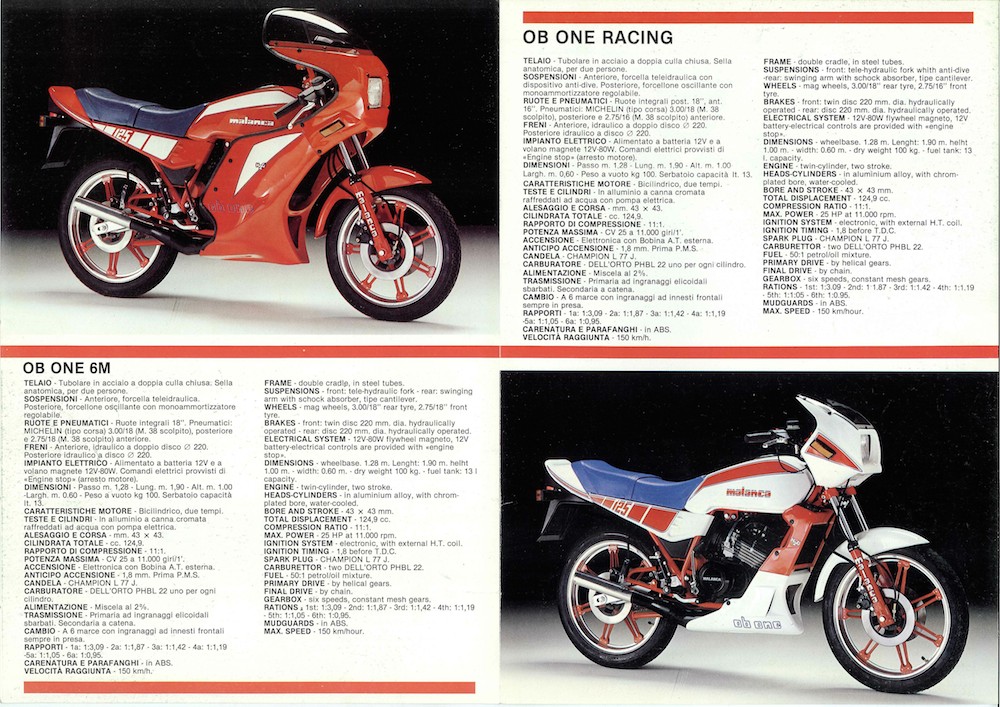
La Racing si distingue per la carena integrale, per i mezzi manubri e per la ruota anteriore da 16”. La Racing adotta un codice omologativo per lei specifico, ovvero DGM 51517 OM.
Nel 1984 la Malanca Ob One Racing è la 125 stradale più potente e veloce sul mercato con un vantaggio di circa 10 Km/ora sulla migliore tra le altre concorrenti di 125 cc.
Alcune OB One Racing vengono prodotte con le forcelle anteriori dotate di anti-dive sia e con la strumentazione che vede l’adozione di un indicatore a led per la temperatura acqua in luogo dell’indicatore normale. Tale equipaggiamento viene montato secondo i pezzi disponibili in fabbrica, quindi la presenza di una dotazione non implica la presenza dell’altra e vice-versa.
La Special: Cocaine 125.
Nel 1984 una ditta di Roma, la RMC, presenta una curiosa versione della Malanca OB One Racing denominata “Cocaine 125”. Non sappiamo molto della suddetta moto e quante ne siano state effettivamente prodotte, ma possiamo supporre che fosse una 125 che “tirava” molto. Se qualcuno avesse notizie sulla RMC, lo preghiamo di contattarci a: j@125stradali.com
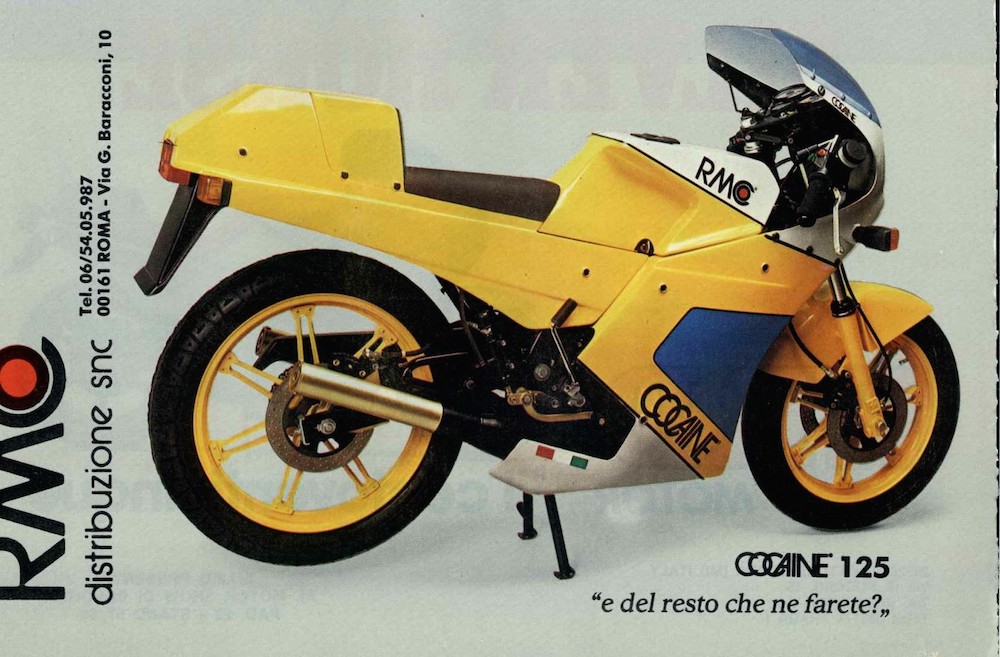
1985: OB One Terza Serie (Prototipo)
Nel 1985 l’erede della OB One era già pronta e doveva essere una moto completamente nuova con una inedita carenatura e delle bellissime pedane pilota passeggero in un solo pezzo in lega leggera.
La ciclistica adotta un telaio in acciaio a tubi quadri, nuove sospensioni e cerchi.
Il motore vede l’adozione di importanti novità che finalmente lo rendono moderno ed al tempo stesso potentissimo. Viene adottata l’ammissione lamellare, le valvole allo scarico a controllo elettronico (anche se al momento erano in fase di collaudo quelle di tipo meccanico), nuove marmitte di espansione con un innovativo sistema atto a potenziarne l’efficacia e finalmente il miscelatore. Il poter contare sul lamellare e sull’adozione delle valvole allo scarico aveva permesso di spingere ulteriormente il diagramma di distribuzione, ottenendo complessivamente almeno altri 5 CV, se questo modello fosse arrivato ai concessionari sarebbe stato il primo 125 stradale nel 1986 forse in grado di sfiorare i 30 Cv “veri” alla ruota.
Purtroppo, la storia è andata diversamente e la Malanca chiude i battenti ritirandosi dalla competizione che di li a poco si sarebbe scatenata dando luogo ad una decina di anni di sviluppo sensazionale nel settore delle 125 stradali. Personalmente sono dispiaciuto dell’epilogo di questo marchio. Mi sarei ulteriormente appassionato nel vedere la crescita di questo motociclo nato nel 1974 sotto la supervisione del valente responsabile del reparto corse “Fuzzi Librenti”, con 15 Cv ed arrivato poco più di 10 anni dopo ad esprimerne il quasi il doppio.
1985 – Mark 125
La Mark 125 viene costruita su base OB One seconda serie, con la quale condivide il motore, sebbene addolcito nell’erogazione.
Per concludere… ecco l’articolo postato su moto.it che ringraziamo come sempre!

